Remembrance Day 2018 - 100 years From Armistice Day 1918: Some Pittwater Veterans from the first world war
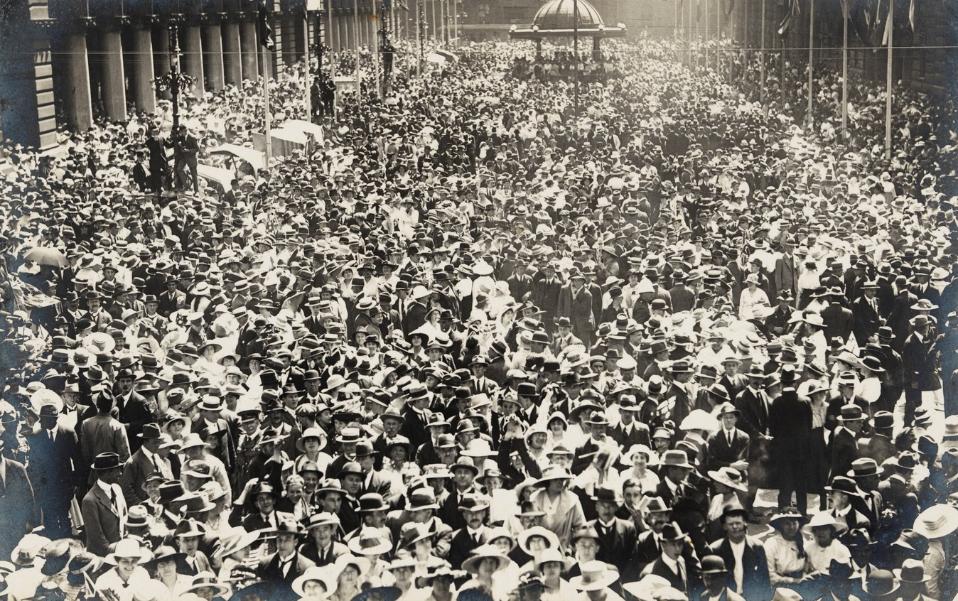
Remembrance Day 2018


“I learned that courage was not the absence of fear, but the triumph over it. The brave man is not he who does not feel afraid, but he who conquers that fear.” —Nelson Mandela
Palm Beach (& Barrenjoey) Carl Beeston GOW
Born Carl W J Beeston Gow at Newcastle in March 1889, the youngest son of Robert and Mary, most people think of Gow’s wharf and boatshed, of the Gonsalves family, and of the Gow’s (brother David and father Robert who also worked there as a relieving and second lighthouse keeper) at Barrenjoey Lighthouse or the ship’s wheel from the Helen B Stirling in the foyer of Club Palm Beach (Palm Beach RSL) whenever they think of Carl Gow.
Many an old salt or those who were knee high and met this man were unaware that he was decorated as a result of his service in WWI, that he went in a private and came our a Captain. Carl was wounded at Gallipoli but remained on duty for two days until sent to hospital. He then went on to serve on the Western Front, took the opportunity to visit Paris when on leave, but just ‘got in with it’ when he finally came home.
Signing up on May 28th, 1915 in Liverpool NSW he gave his employment as Mail Order Manager or ‘Under Manager’. By the 16th of June he was embarking on HMAT Karoola A63 as part of the 6th Reinforcements of the 3rd Battalion AIF (New South Wales) [1st Infantry Brigade]. The Karoola was one of a fleet of transport ships leased by the Commonwealth government for the specific purpose of transporting the various AIF formations to their respective overseas destinations. His Majesty's Australian Transports (HMAT) were also detailed to carry various commodity exports to Britain and France. The fleet was made up from British ships and captured German vessels.
Carl was allotted – 3 blankets, 1 waterproof, 1 jacket/tunic, 1 pair dungarees, 1 Whity hat, 1 pair of boots, 2 singlets but no socks.
Mr Gow was assigned to the 3rd Battalion. The 3rd Battalion was among the first infantry units raised for the AIF during the First World War. Like the 1st, 2nd and 4th Battalions it was recruited from New South Wales and, together with these battalions, formed the 1st Brigade.
The battalion was raised within a fortnight of the declaration of war in August 1914 and embarked just two months later. After a brief stop in Albany, Western Australia, the battalion proceeded to Egypt, arriving on 2 December. The battalion took part in the Anzac landing on 25 April 1915 as part of the second and third waves and served there until the evacuation in December.
In August, this battalion took part in the attack on Lone Pine.(1.)
Carl survived this battle but on the 21st of August 1915 he was wounded. His records state he remained on duty and 'Wounded MFC', meaning 'Mortar Fire Controller' is next to this notice in his War Records. On the 23rd of August he was sent to hospital and on the 24th was transferred to Mudros as a result of his wounds and admitted into the 1st Australian Casualty Clearance Station there.
Mudros is a small Greek port on the Mediterranean island of Lemnos. It was utilised during World War One as a base from which to launch the Gallipoli campaign as the Allies attempted to seize control of the Dardanelles Straits, some 50km away. There is a cemetery there in which fifty Australians are buried.
His father had this to say about his being wounded so soon after being deployed:
PRIVATE CARL GOW.
Mr. Robert Gow, of East Newcastle, has recieved an intimation from the Defences Department, that his son, Prtvate Carl B. Gow, had been wounded at the Dardanelles. In forwarding the information for pubIication, Mr. Gow says:--"I may state he enlisted in June last, and was only one weekend In camp, when he left with the 6th Reinforcements of the Third Battalion, on 16th June, arriving In Egypt on 17th July. He spent only seven days in Egypt, and then went to the front, He never had a day's training In his life, and I think greater care should be taken, not to allow untrained lads to go straight into the fighting line, no matter how keen their desire to get there may be. Before he enlisted, my son was employed at Winn and Company's, Oxford-street, Sydney. He was in charge of their country order department. He had been with Winn and Company since he was fourteen years of age. He is now 20. PRIVATE CARL GOW. (1915, September 14). Newcastle Morning Herald and Miners' Advocate (NSW : 1876 - 1954) , p. 5. Retrieved from http://nla.gov.au/nla.news-article137969100
Tall al Kebir or Tel-el-Kebir ('great mound') is 110 km north-north-east of Cairo and 75 kilometres south of Port Said on the edge of the Egyptian desert at the altitude of 29 m. During the Gallipoli landings and the Sinai and Palestine Campaign of the First World War, Tel el Kebir was a training centre for the First Australian Imperial Force reinforcements, No 2 Australian Stationary Hospital, and also a site of a large prisoner of war camp. Some 40,000 Australians camped in a tent city at Tel-el-Kebir of six miles in length. A military railway was eventually constructed to take troops from the camp to their vessels in Alexandria and elsewhere for embarkation.
The Tel-el-Kebir village was described by an Australian soldier in 1916 as 'a very dirty little place with a few dirty shops in it'
An Allied War Memorial Cemetery is situated about 175 metres east of the railway station and the Ismailia Canal. The War Memorial Cemetery was used from June 1915 to July 1920, and was enlarged after the Armistice with many graves being transferred in from other temporary interment sites. The camp was converted for use as a holding camp for refugees fleeing the Russian Civil War from what used to be southern Russian Empire.
On the 19th of February, 1916 Carl Gow, along with what was left of the 3rd Battalion was transferred to the 55th Battalion. The 55th Battalion was raised in Egypt on 12th of February 1916 as part of the “doubling” of the AIF. Half of its recruits were Gallipoli veterans from the 3rd Battalion, and the other half, fresh reinforcements from Australia.
Carl’s war Records state that in March the 55th Battalion embarked at Alexandria on the HMT Caledonian and disembarked at Marseilles, France soon after.
The Australian War Museum states:
‘Reflecting the composition of the 3rd, the 55th was predominantly composed of men from New South Wales. The battalion became part of the 14th Brigade of the 5th Australian Division.
Arriving in France on 30 June 1916, the battalion entered the frontline trenches for the first time on 12 July and fought its first major battle at Fromelles a week later. The battle was a disaster, resulting in heavy casualties across the division. Although in reserve, the 55th was quickly committed to the attack and eventually played a critical role, forming the rearguard for the 14th Brigade’s withdrawal. Despite its grievous losses the 5th Division continued to man the front in the Fromelles sector for a further two months.
The Australians were given a gradual introduction to the Western Front fighting conditions. It was a new experience for them. They trained with some of the latest weapons of modern warfare including poisonous gas. Things became more serious when they moved into the front line trenches in a section around Armentières which had been dubbed "the nursery".
Meanwhile the British army, under Sir Douglas Haig, was about to conduct a mighty offensive in the Somme region, 100 km away to the south. The battle was set for 1 July, and it would continue for five months. It began disastrously; there were 58,000 casualties on the first day and little ground was taken. As the fighting went on three Australian divisions, the 1st, 2nd and 4th Divisions, were eventually drawn in, leaving the 5th Division under Major General James McCay, behind. This newly arrived 5th Division would be the first to see heavy action.
Just beyond the line held by the Australians in the nursery sector was the shell-damaged village of Fromelles standing on a strategically important ridge behind the German front line. The surrounding battlefield had been fought over by the British during 1915, and now a fresh attack against the ridge was planned. It was hoped that a strong diversionary attack here would prevent the Germans sending troops to reinforce their defences on the Somme. The attack was set for the evening of 19 July and the Australians and another untried British division, the 61st, were chosen to make the effort.
The attacking troops were not familiar with Fromelles itself because it was in German hands; for them the nearest village was Fleurbaix which stood behind their own lines. For a long time afterwards many would refer to the events about to unfold as the battle of Fleurbaix, but eventually the name of Fromelles stuck and today it is by that name that the battle is known.
On this battleground the opposing trench lines faced each other across a flat, boggy and overgrown no man's land criss-crossed with drainage ditches and a small stream. Because of the high water table, the trenches were mostly above-ground breastworks. Of deadly concern, sited within the enemy lines was the "Sugarloaf" salient. This was a heavily manned position with many machine-guns that jutted towards the British lines. Fire from here could enfilade any troops advancing towards the ridge. The enemy held the high ground and all of the advantages.’(1.)
Although the Australian Imperial Force strength in France varied in response to battle casualties and problems with recruiting, it never fell below 117 000 men. Its battle casualties for three years of trench warfare between 1916 and 1918 amounted to over 181 000 men of whom more than 46 000 died. Another 114 000 were wounded, 16 000 were gassed and almost 4000 taken prisoner. In terms of total deaths per 1000 men mobilised, the Australian Imperial Force figure was 145 – the highest of all the British Commonwealth armies.
Carl Gow was promoted to R.Q.M.S.W.O. Class II on the 14th of April,1916 (Regimental Quartermaster Sergeant) - The RQMS is the senior assistant to the quartermaster of a regiment or battalion and also usually functions as the deputy regimental sergeant major. Some units have more than one. RQMS was a separate rank until 1915, when it became a warrant officer appointment with the creation of the rank of warrant officer class II.
Carl Gow was promoted again to 2nd Lieutenant on August 2nd, 1916 and Lieutenant on the 9th of February, 1917.
As a Quartermaster he made trips to and from Rouen. During the First World War the British used Rouen as a supply base and there were many military hospitals. It is also the place well known for being where you may find Notre Dame cathedral and an astronomical clock dating back to the 16th century, though the movement is considerably older (1389), is located in the Gros Horloge street.
Other famous structures include Rouen Castle, the Gothic Church of St Maclou (15th century); the Tour Jeanne d'Arc, where Joan of Arc was brought in 1431 to be threatened with torture (contrary to popular belief, she was not imprisoned there) and the Museum of Fine Arts and Ceramics which contains a splendid collection of faïence and porcelain for which Rouen was renowned during the 16th to 18th centuries. (2.)
Carl Gow was mentioned in dispatches 25th December 1917; London Gazette; Sir Douglas Haig’s Despatch
He was Awarded the Military Cross on the 4th of June 1918. The Military Cross is granted in recognition of "an act or acts of exemplary gallantry during active operations against the enemy on land to all members, of any rank in Our Armed Forces…"
Carl Gow’s records record these words and also the dates ‘from 26.2.1917 to 25.9.1917’. From those who met him when he came to Palm Beach:
You still quite young when you met Carl?
Peter Verrills: he was a wonderful man. A man full of knowledge.
Did you know he was a Captain at the end of WWI?
Peter: yes, in the Army, First world war. He got blasted to buggery – they sent him to France and then he walked away.
John Arblaster: he found this solider with his leg blown off, and he threw his greatcoat over him, to keep him warm until the Medics got to him. Later on in life when he was here at the boatshed, there was a fella that bought a house up on the hill there. His name was Harold Richardson and this turned out to be the solider who he had saved.
Peter Verrills: Harold Richardson, unbeknown to Carl, was his batman. They were good mates until he died and Harold became the secretary of the Palm Beach RSL when that first opened. I remember Harold as a kid; he used to get around in a Ford with a big gas burner on the back of it because there wasn’t enough petrol then.
During this period the 55th Battalion, after a freezing winter manning trenches in the Somme Valley, were part of the early 1917 advance that followed the German retreat to the Hindenburg Line. Although spared the assault they did defend gains made during the second battle of Bullecourt. Later in the year, the AIF’s focus of operations switched to the Ypres sector in Belgium. The 55th’s major battle here was at Polygon Wood on 26 September.
MILITARY HONOURS. The "London Gazette" contains the following list of members of the Australian and New Zealand Expeditionary Forces who have been decorated: BARS TO MILITARY CROSSES. Australians.-Captain F. E. Fairweather, Lieutenant J. H. Julln. MILITARY CROSSES. Australians.- Quarter masters R. J. Forrest, C. B. Gow, MILITARY HONOURS. (1918, June 6). The Sydney Morning Herald (NSW : 1842 - 1954), p. 7. Retrieved from http://nla.gov.au/nla.news-article15786666
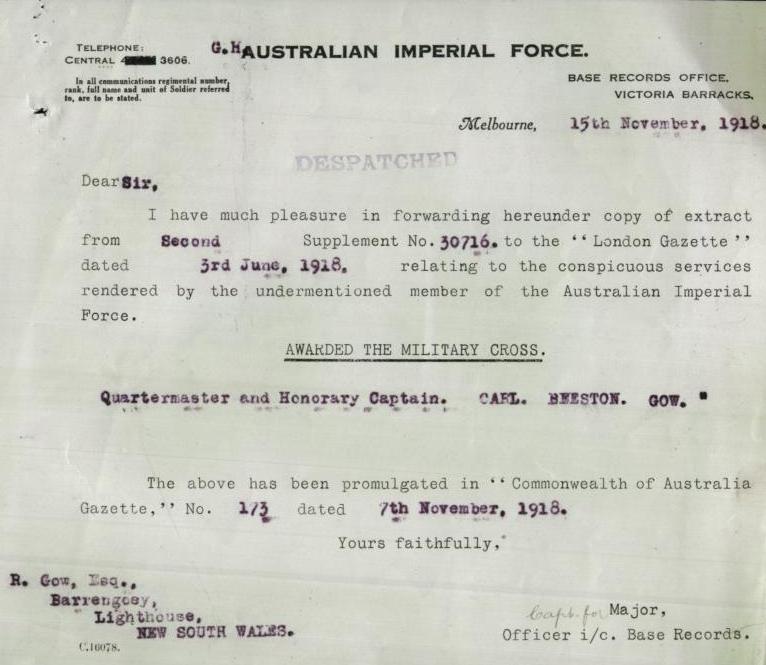
Later that year he was granted Leave and went to Paris – 27th of September 1918. On the 13th of December 1918 Carl was made an Honorary Captain.
On March 1st 1919 he was sent on Leave to the U.K. for Investiture, reporting to the Headquarters in London on the 4th of March.
In 1920 he also received the 1914–15 Star, a campaign medal of the British Empire, for service in World War I, the British war Medal and the Victory Medal.
Meanwhile his father, Robert sent a letter from Barrenjoey Lighthouse dated 13.3.1919 requesting information about Carl who is still in France or on way home??? No one knew where he was.
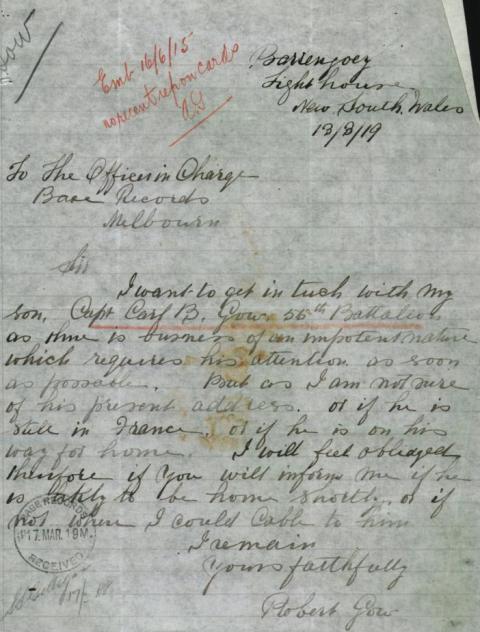
Carl Gow returned to Australia per the ‘Traz os montes’ or ‘Eros Montes’ as spelled in some files.
He disembarked on the 22nd of May 1919 and made his way here to be reunited with his family then lightkeepers at Barrenjoey where he also then worked as a relieving lightkeeper. It was a few days over four years when he finally came home and days before he resumed or took up a new way of life.
His smile from the few photographs* shared by those who knew him show he just decided to get on with life. Mr Gow was, after all, a man who thought nothing of rowing from Barrenjoey to Newcastle to take part in a SLS Boat Carnival once he did get home and became part of the permanent Palm Beach community, becoming one of the founding members of the Palm Beach RSL club.
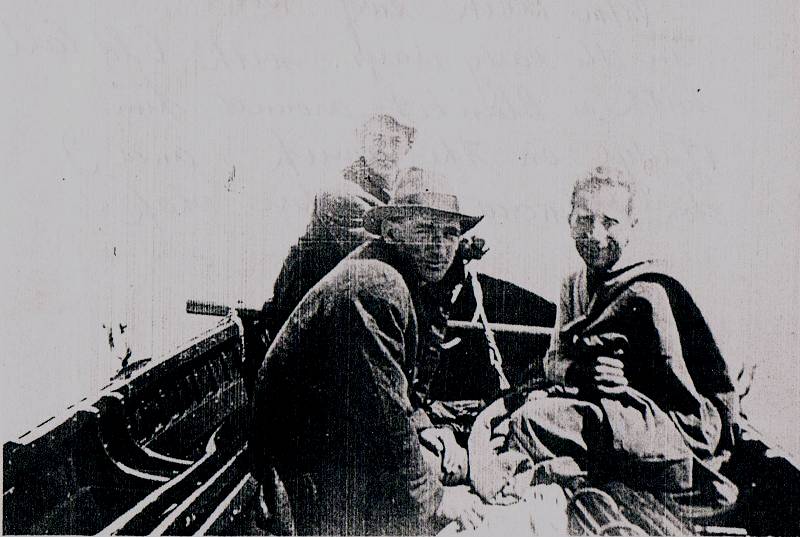
He was also a friend of fellow 55th Battalion Soldier Reginald Howlett and the two went into business together at what would later be known as the Gow-Gonsalves Boatshed, tucked under Observation Point.
He was truly a Honorary Captain both on land and at sea.
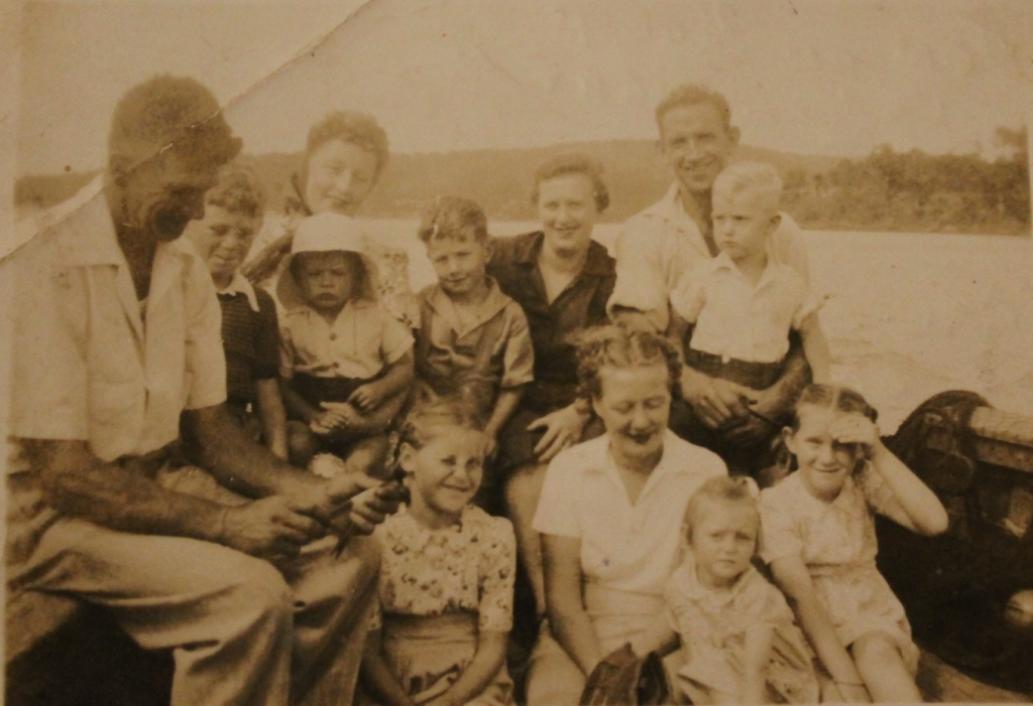
Carl Gow at far right, back row. Image Courtesy Tom Gilbert who is wearing the white hat, pictured with members of Lipscombe, Gilbert and Gonsalves families
Careel Bay (& Narrabeen) Jack Lawson HASTIE
Regimental number 59256
Place of birth North Sydney New South Wales, birth registered at St. Leonards - born 28th of July 1898 to Charles J and Margaret Flemming (nee Hamilton - married 1896 in Sydney)
Religion Church of England
Occupation Motor driver
Address Manly, New South Wales
Marital status Single
Age at embarkation 19
Next of kin: Mother, Mrs M Fleming-Boulton, Gladstone Street, Newport, New South Wales
Enlistment date 30 May 1918
Rank on enlistment Private
Unit name New South Wales Reinforcement 12
AWM Embarkation Roll number 23/111/5
Embarkation details Unit embarked from Sydney, New South Wales, on board HMAT A30 Borda on 17 July 1918
Rank from Nominal Roll Private
Unit from Nominal Roll 18th Battalion
Fate Effective abroad (still overseas)
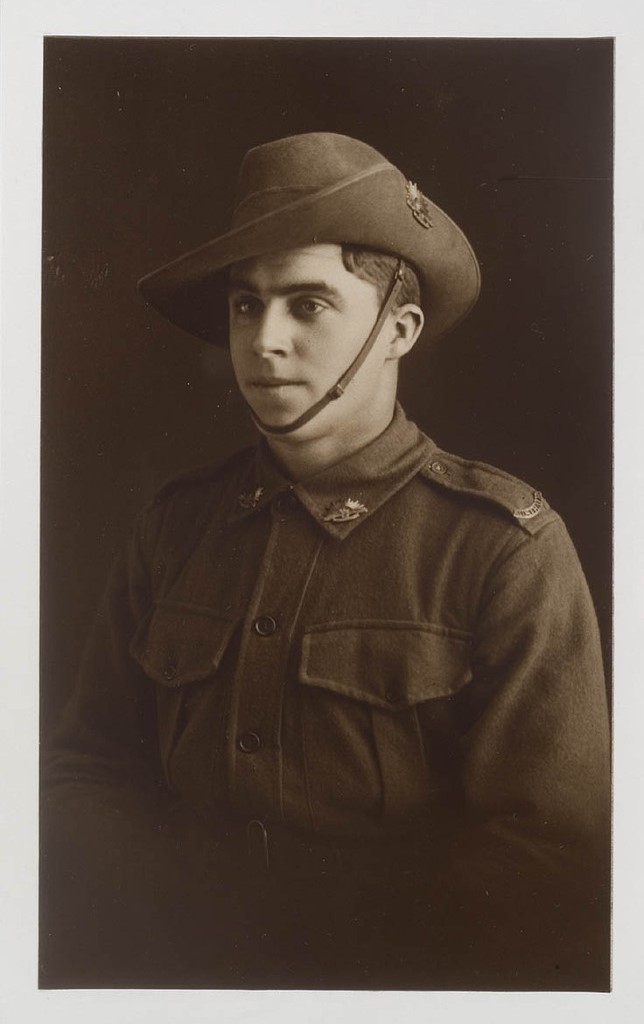
Jack Lawson Hastie Image No.: a871628h, courtesy State Library of NSW
Jack Hastie was sent into France on the 27th of September 1918, attached to the 18th Battalion.
In early 1918, following the collapse of the Russian resistance on the Eastern Front, the Germans had been able to transfer a large number of troops to the Western Front. As a result, in March, they launched their Spring Offensive. With the Germans making rapid gains, Australian units, including the 18th Battalion, were moved south from Belgium where they had spent the winter and they were thrown into the line to help blunt the attack around Villers-Bretonneux, which lay before the strategically important rail hub at Amiens. After this, in August the Allies were able to launch their own offensive, which subsequently became known as the Hundred Days Offensive and ultimately brought about the Armistice. During this offensive, the battalion fought at Amiens and Mont St Quentin before assaulting "Beaurevoir Line", which was the third (and final) fortified line of the Hindenburg Line. There, at Montbrehain, on 3 October 1918, Lieutenant Joseph Maxwell earned the battalion's first and only Victoria Cross in what was ultimately to prove their last engagement of the war. After this the units of the Australian Corps, severely depleted due to heavy casualties and limited reinforcements, were withdrawn from the line upon the insistence of the Australian prime minister, Billy Hughes, for rest and re-organisation and did not return to the front before the Armistice was declared on 11 November 1918. [1.]
On the 1st of February 1919 Jack was attached to the Australian Graves Detachment and sent into Belgium. He served there until the 24th of March 1919. On the 16th of March 1919 he was attached to the Graves Registration Detachment sent into France. He served there until the 16th of August 1919.
Above: Members of the Graves Registration Detachment, Australian section, of the Imperial War Graves unit loading bodies from a mass grave to be put in single graves. The bodies are wrapped in groundsheets with ID tags after exhumation and prior to reburial in permanent war cemeteries. Image P04541.001, courtesy Australian War Memorial.
Unidentified members of No 5 Company of the Australian War Graves Detachment at work digging graves at the Villers-Bretonneux cemetery. Image No.: E05494, courtesy Australian War Memorial.
The Graves Registration Detachment served a sacred duty to those who would not be sent home, although obviously the work these men, with Jack just 20 years of age by then, would have haunted them for the rest of their lives.
It would be the 18th of December 1919 before Jack embarked to come home, aboard the Kryja Luise. He was discharged on the 1st of March 1920.
His grandparents were Charles John Hastie and Eliza Lawson who emigrated to Australia in 1833. They had been married in 1830 and had two children Jessie (Janet Jessy) and 'Creamer' (?) prior to coming to Sydney. NSW Births, Marriages, Deaths indexes shows five children born in NSW - Eliza (1834) Charles John Lawson (1839) John Sutherland (1842) Margaret R M L (1845) and Alexander Bunyan (1849).
Charles, a baker, passed away in 1859 or 1860 and Eliza remarried -
HORTON-HASTIE-At the Scots Church, by special license, by the Rev. Dr. Lang, M.P., on Thursday, the 30th January, Mr. William Horton, farmer, Kingsgrove, a native of Portsmouth, England, to Mrs. Eliza Hastie, relict of the late Mr. Charles Hastie, of Sydney, and sister of Alexander and John Lawson, Esqrs., veterinary surgeons, Bolton and Manchester, a native of Paisley, Scotland. Family Notices (1862, January 31). Empire (Sydney, NSW : 1850 - 1875), p. 1. Retrieved from http://nla.gov.au/nla.news-article60508121
Her daughter Eliza passed away in 1874:
THE FRIENDS of Messrs. CHARLES and JOHN HASTIE are respectfully invited to attend the Funeral of their late deceased SISTER, Eliza : to move from their mother's residence, Parramatta-street, near Abercrombie-street, on THURSDAY MORNING, at half-past 8 o'clock. J. and G. SHYING and CO.
THE FRIENDS of Mrs. ELIZA HASTIE are respectfully invited to attend the Funeral of her late deceased DAUGHTER, Eliza; to move from her residence, Parramatta-street, near Abercrombie-street, on THURSDAY MORNING, at half-past 8 o'clock, for Necropolis. J. and G. SHYING and CO., 120, Oxford-street. Family Notices (1874, April 8). The Sydney Morning Herald (NSW : 1842 - 1954), p. 10. Retrieved from http://nla.gov.au/nla.news-article13334455
Eliza senior passed away in 1877
DEATHS. HASTIE-BAKER.-July 26. at Sydney. Eliza Lawson Hastie, in her 66th year. Family Notices (1877, August 24). Evening News (Sydney, NSW : 1869 - 1931), p. 2. Retrieved from http://nla.gov.au/nla.news-article108199065
HASTIE-BAKER.—July 26, at Sydney, Eliza Lawson Hastie, in her 66th year, relict of the late Charles Hastie-Baker, and mother of Mrs. M. Harrison, Castlereagh-street. Family Notices (1877, September 1). The Sydney Mail and New South Wales Advertiser (NSW : 1871 - 1912), p. 549. Retrieved from http://nla.gov.au/nla.news-article166861475
FUNERALS THE FRIENDS of CHARLES and JOHN HASTIE are invited to attend the Funeral of their deceased MOTHER, Eliza ; to move from the residence of her daughter, Mrs. J. Dent, Parramatta-street, THIS (Friday) AFTERNOON, at a quarter past 2, for the Necropolis. J. and G. SHYING and CO., Undertakers, 120, Oxford-st. THE FRIENDS of Mr. THOMAS GATES are invited to attend the Funeral of the late Mrs. ELIZA HASTIE ; to move from the residence of her daughter, Mrs. J. Dent, Parramatta-street, THIS (Friday) AFTERNOON at a quarter past 2, for the Necropolis. Family Notices (1877, July 27). The Sydney Morning Herald (NSW : 1842 - 1954), p. 10. Retrieved from http://nla.gov.au/nla.news-article28396556
Charles John Lawson Hastie married Annie (sometimes spelled Anna and Hannah)Maria Wright in 1864. NSW Births, Deaths and Marriage records lists the following children from the union:
HASTIE CHARLES JOHN LAWSON 686/1865 CHARLES J L ANNIE M SYDNEY
HASTIE WILLIAM A 1337/1867 CHARLES J LANNIE M SYDNEY
HASTIE ALEXANDER J 1840/1869 CHARLES J L ANNIE M SYDNEY
HASTIE JOHN A 2923/1871 CHARLES J L ANNA M SYDNEY
HASTIE ARCHIBALD JOSEPH 331/1874 CHARLES JOHN LAWSON ANNIE MARIA SYDNEY
HASTIE JAMES A 1939/1876 CHARLES J ANNIE M SYDNEY
HASTIE ALEXANDER HERBERT 3358/1878 CHARLES J L ANNIE M SYDNEY
HASTIE JOSEPH C 9616/1882 CHARLES J L ANNIE M MANLY
HASTIE ELIZA MARY 11927/1884 CHARLES ANNA M MANLY
HASTIE-— August 13, at 14 M'Dougal-street, North Shore, John, the beloved son of Charles Hastie, Broken Bay, aged 23 years. Family Notices (1894, August 14). The Australian Star (Sydney, NSW : 1887 - 1909), p. 1. Retrieved from http://nla.gov.au/nla.news-article227494433
HASTIE JOHN A 12471/1894 CHARLES J ANNA M ST LEONARDS
Annie passed away in 1895.
HASTIE. - June 24, at St Vincent's Hospital, Hannah Maria, wife of Charlie Hastie. Family Notices (1895, June 26). The Sydney Morning Herald (NSW : 1842 - 1954), p. 1. Retrieved from http://nla.gov.au/nla.news-article14009101
HASTIE.—In memory of our beloved mother, Annie Maria Hastie, who departed this life June 26th, 1895. Beloved by all who knew her. Inserted by her loving sons and daughter, Charles, William, James, Alick, Joseph, and Eliza Hastie, Dead, but not forgotten. Family Notices (1897, June 26). The Sydney Morning Herald (NSW : 1842 - 1954), p. 1. Retrieved from http://nla.gov.au/nla.news-article14118905
Charles John Lawson Hastie Senior married Margaret Flemming Hamilton in 1896. NSW Births, Deaths and Marriage records lists the following children from the union:
HASTIE JESSIE E 34523/1896 CHARLES J MARGARET F ST LEONARDS
HASTIE JACK L 25298/1898 CHARLES J MARGARET F ST LEONARDS
HASTIE GEORGE C 16528/1900 CHARLES J L MARGARET F ST LEONARDS
HASTIE LILLIAN M 16119/1902 CHARLES J MARGARET REDFERN
HASTIE SAMUEL E 13849/1904 CHARLES J MARGARET F MANLY
HASTIE RUPERT C 15121/1906 CHARLES J MARGARET F MANLY
HASTIE CECIL 15735/1908 CHARLES J MARGARET F MANLY
HASTIE BLANCHE 15736/1908 CHARLES J MARGARET F MANLY
HASTIE ALICE M 26933/1909 CHARLES J MARGARET F MANLY
HASTIE MARGARET E 38045/1912 CHARLES J MARGARET F SYDNEY
Mr. Charles John Lawson Hastie senior passed away in September 1912, his residence per the funeral notice given as 11 Harwood Lane, Pyrmont. He was interred at Rookwood in the Presbyterian section.
Margaret remarried in 1913, the marriage was registered at Canterbury, her husband was Richard Boulton. Richard was a son of William and Sarah Boulton (sometimes spelled Bolton) - the Boultons who had the Newport Hotel (from 1882), Mona Vale farm prior to that (from 1872), and ran the coaches as well as mail. Richard was born in 1874. His brother Edward was born in 1877, sister Eva in 1881.
Only one child shows up in the timespan allowed in NSW BDM's Records:
BOULTON BARBARA 12741/1914 RICHARD MARGARET F MANLY
More Boultons (James - died 1934 and George - died 1927 - are missing from this list):
BOULTON.—August 30, 1941, suddenly at Newport, John Boulton, dearly beloved brother of Richard, Samuel, William, Henry, and Edward Boulton, aged 76 years. Family Notices (1941, September 2). The Sydney Morning Herald (NSW : 1842 - 1954), , p. 12. Retrieved from http://nla.gov.au/nla.news-article17751690
William Boulton passed away in 1897.
BOULTON -December 28 at Newport, William Boulton, sen., aged 67 years. Family Notices. (1897, December 29). The Sydney Morning Herald (NSW : 1842 - 1954), p. 1. Retrieved from http://nla.gov.au/nla.news-article14174925
The Boulton family held on to the hotel until 1919, meaning that everyone who leased the hotel between 1884, when William Boulton first started transferring the liquor licence and lease to others, and 1919 were leasing it from the Boultons:
NEWPORT HOTEL. WILLIAM BOULTON begs to inform the public that, having taken the above, he is prepared to offer the best accommodation to pleasure - seekers and others. Choicest Assortment of LIQUORS kept. Coaches run from Manly MONDAYS, WEDNESDAYS, THURSDAYS, and FRIDAYS, at 8 a.m., for Newport and Gosford ; FRIDAYS for the Hawkesbury River, at 3.30 p.m. Advertising (1882, April 17). The Sydney Morning Herald (NSW : 1842 - 1954), , p. 12. Retrieved from http://nla.gov.au/nla.news-article13509543
SYDNEY. FRIDAY, SEPTEMBER 10. At Half-past Eleven O'clock. By Order of the Trustees of the Estate Late WILLIAM BOULTON, NEWPORT, PITTWATER, On the Water-front of This Beautiful Seaside Resort, the Newport HOTEL, A Popular, Up-to-date House, so Easy of Access to the City by Regular Motor Service, Close to the Ocean Beaches. Adjoining The Newport Wharf. Erected on Land Having 167ft. 6in. to Queen Street, at the Foot of Beaconsfield Street, and 349ft. to Queen's Parade. The South-Eastern Depth Line is 297ft., Extending in Part to and Having a Large Frontage to the waters of Pittwater and to the Wharf Reserve.
"RICHARDSON and WRENCH LTD. will SELL by AUCTION, at the rooms, 92 Pitt street, Friday, 19th September, at half-past eleven o'clock The above well-Known WATER-FRONTAGE HOTEL, NEWPORT.- PITTWATER. Messrs. A. J. Reynolds-and White, 88 Pitt street, solicitors to the estate.-.' Classified Advertising. (1919, September 6). The Argus(Melbourne, Vic. : 1848 - 1956), p. 22. Retrieved from http://nla.gov.au/nla.news-article4694809
BOULTON MARGARET FLEMMING 10750/1957 80 YEARS DEE WHY MANLY - NSW Births, Deaths and Marriage records
Richard passed away in 1963.
Charles John Lawson Hastie Junior married Isabella Jane Harris in 1890, they had two sons and three daughters,
HASTIE JESSIE I 312/1896 CHARLES J ISABELLA J
HASTIE ARCHIBALD C 26242/1900 CHARLES J ISABELLA J ST LEONARDS
HASTIE CHARLES J 28419/1902 CHARLES J ISABELLA J
HASTIE ELIZABETH L M 36589/1904 CHARLES J ISABELLA J
According to Ned Robinson the area along Careel Bay was known as 'Hastie's Flat'.
Charles and Isabella lost their first born son just seven years after he was born:
FUNERALS. HASTIE.-The Friends of Mr. and Mrs. CHARLES HASTIE are respectfully invited to attend the Funeral of their late dearly loved SON, Charles John; to leave their residence, 2 Little Arthur-street, North Sydney, THIS FORENOON, at 11 o'clock, for St. Thomas' Church of England Cemetery. COFFILL and COMPANY, Funeral Directors. Family Notices (1903, February 17). The Sydney Morning Herald (NSW : 1842 - 1954), p. 10. Retrieved from http://nla.gov.au/nla.news-article14491801
Soon after they lost Archibald too, aged just three:
HASTIE CHARLES J 3631/1903 CHARLES J ISABELLA A ST LEONARDS
HASTIE ARCHIBALD C 7743/1903 CHARLES J ISABELLA A
HASTIE. The Friends of Mr. and MRS. CHARLES HASTIE are respectfully invited to attend the Funeral of their late dearly loved son. Archibald Charles; to leave their residence, 2 Little.Arthur-st., North Sydney, THIS DAY, at 3.35 for St. Thomas Cemetery. COFFILL and COMPANY, Sydney, Balmain, North Sydney, Pyrmont, etc. Tel. ... Family Notices (1903, April 14). The Daily Telegraph (Sydney, NSW : 1883 - 1930), p. 8. Retrieved from http://nla.gov.au/nla.news-article237398230
In 1904 the school launch was taking children to Bayview school, then run by Samuel Morrison. Among the children conveyed from Careel Bay are Eric, Jack, Jessie and Isabel Hastie.
Charlie Hastie, a well-known fisherman of Pittwater, says that black bream, flathead, and flounder are now fairly plentiful about Careel Bay and the mouth of Pittwater, and advises anglers to give the place a trial. FISHING NOTES. (1906, February 3). Evening News (Sydney, NSW : 1869 - 1931), p. 5. Retrieved from http://nla.gov.au/nla.news-article114224127
EXCHANGE OF FLAGS.
The school at Newport on Saturday was gay with bunting, on the occasion of the flying for the first time of the flag sent from Newport. Isle of Wight. There was a large gathering, scholars being present from Narrabeen, Newport, and Mona Vale. Mr. J. B.. Nicoll - presided and Mr. J. A. Hogue 'broke' the flag amid loud cheers. Mr. Hogue, Minister for Public Instruction, said the interchange of Sags was in the best interests of the Empire. It was a new growth of patriotism, that .brought the distant ports of the Empire Into closer touch. and strengthened the bonds of the nation. No country strove so much for peace, as did Great Britain. The reign of King Edward was one of unbroken peace. Other speakers were Councillors Powell, Nott, and Quirk, and Mr. De Wilde, who gave a history of Newport, Isle of Wight. Mr. Watt sang 'The Death of Nelson,' and the Mona Vale Band played selections. The children of the different schools rendered choruses, and , were regaled with refreshments. The ladies who worked during the day were Mesdames Greig, Powell, Morris, Hastie, Proven, Harper, and Aster, and Miss Harper. EXCHANGE OF FLAGS. (1910, June 20). Evening News (Sydney, NSW : 1869 - 1931), p. 8. Retrieved from http://nla.gov.au/nla.news-article115237480
Jessie Hastie (born 1896)married Frederick James Wilson (born 1889) in 1914. Frederick was the son of Thomas and Frances (nee Oliver) Wilson. His grandfather was the Thomas Wilson who first came to Pitt Water in 1841 as the lessee of “Mona Vale” farm. The above mentioned Albert Turner was married to his aunt, Nancy (b.1852, married Albert H. Turner 1872).
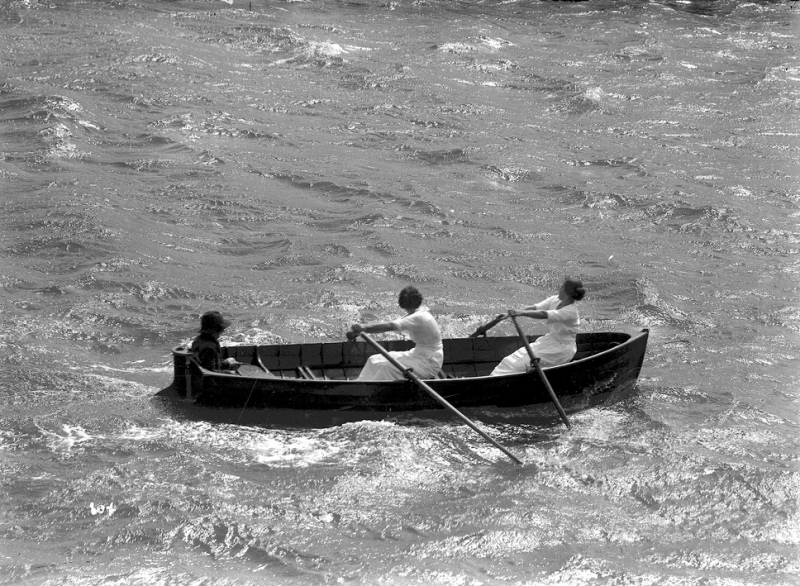
Mrs J Wilson and Miss Hastie, Careel Bay ladies, winning the Ladies Double Sculls at the Pittwater Regatta, during the 2nd Regatta for 1921 - held on December 31st. This image appears in The Sydney Mail, 4 January 1922, page 18. The caption for the image includes the following details: 'The winners had a handicap of 15s, the distance being a mile. Mrs Hendrie and Miss Beaumont were second, and Mrs Allen and Miss K. Bolt (3s) third.' Image 12152 courtesy Australian National Maritime Museum. See: PITTWATER REGATTA : THE GOVERNOR-GENERAL'S WIN. (1922, January 4). Sydney Mail (NSW : 1912 - 1938), p. 18. Retrieved from http://nla.gov.au/nla.news-article169769804
The December 31st 1921 Pittwater Regatta rowing results:
ROWING EVENTS.
YOUTHS' SINGLE SCULLS HANDICAP (18 years and under).— C. Johnson, 25sec, £2, 1; R . Ellis, scr, 2. Won easily by 10 lengths.
LADIES SINGLE SCULLS ALLCOMERS' HANDICAP.— Mrs. Willsber, 7sec, £5, 1; Miss M.Gray, 8sec, £2, 2; Miss N. Lorvick, lOsec, £1,3. Won by five lengths, with three lengths between second and third.
GENTLEMNS DOUBLE SCULLS LOCAL HANDICAP (with coxswain).— G. Godholt and W. Oliver, 90sec, £5,1; J. Wilson and G. Hastie, Scr, £2, 2; R. R. Hickson and F. Hall, 45sec, 3.
LADIES' DOUBLE SCULI.S (all-comers, with coxswain).— Mrs Jessie Wilson and Miss Isobel Hastie, 15sec, £5, 1; Mrs. Hendrie and Miss Beaumont, scr, £2, 2; Mrs. Allan and Miss K. Boati, 3.-cc. £1, 3. A great race. Won by half a length, with three-quarters of a length between second and third.
OLD BUFFERS' SINGLE-SCULLS HANDICAP.— F. Anderson, scr, £2/5/, 1; Jas. Boulton, 25 secs £1, 2; G. Godbolt, 30sec, 10/, 3. Won by three lengths.
LADIES AND GENTLEMEN'S DOUBLE SCULLS (all-comers).-Mrs. Jessie Wilson and Mr. Joe Arblaster, 20secs, £5, 1; Miss Isobel Hastie and Mr. Jack Wilson, scr, £2, 2; Miss Myrtle Gray and Mr. Fred Gray, 45 sec, 3. Won by a length, with one and a half length between second and third.
GENTLEMEN'S SINGLE SCULLS (local handicap).— J. Wilson, scr, £5, 1; G. Erickson, 22sec,£2, 2; J. F. Duffy, 10.sec, £1, 3. A close finish. Won by three feet, with two feet between second and third. PITTWATER REGATTA. (1922, January 1). Sunday Times(Sydney, NSW : 1895 - 1930), p. 8. Retrieved from http://nla.gov.au/nla.news-article128213474
Primary Application - Charles John Hastie 2 acres on Bay View Road & Careel Bay, Pittwater in Parish Narrabeen County Cumberland Shire Warringah Volume 3946 Folio 207 Date range: 01/05/1926 to 11/12/1926 (from State Records, NSW).
'DOG WAS MURDERED' Caretaker Claims Damages APOLOGY ACCEPTED
SYDNEY. Tuesday. 'Buster' was an Australian terrier and was the pet of the family of Addison Parker, of Careel Bay, Newport. 'Buster' was .found dead between his home and the local wharf. Parker examined the tracks with a magnifying glass, measured foot-prints, and came to the conclusion that 'Buster' had been strangled. Today, before Judge Cohen and a Jury in the District Court, George Moule, caretaker for Dr. Elliott, of Careel Bay, sued Parker for £400 for alleged libel. According to Moule, Parker wrote a letter to Elliott, in which he said that about 2 a.m. on August 28, a commotion was heard at the back fence of Elliott's residence. 'Buster' had not been poisoned, but strangled, and the body carried a few yards up the track 'leading from the public wharf to Parker's place.' There the culprit cut the tie from the dog's neck.' said the letter.' A powerful magnifying glass discloses that the dog had been laid down and the tie cut at that spot, but the clumsy criminal left evidence and the article that he used for the purpose' The tracks of the man Indicated that he was a tall man. The only men that slept In Careel Bay that night were Hastie, Wilson, Moule, and myself. Neither Hastie nor Wilson would do such a thing as this, the act is traceable to a clumsy, unintelligent, heartless and common man. It was cold-blooded murder. I have been frequently annoyed by your caretaker. That our dog was murdered at your back fence at 2 a.m. is without a doubt.' Some men would have rushed to the police , straight away without employing Sherlock Holmes: I believe I have acted honorably in writing to you,' the letter added. The case for Moule was, that the letter meant that Moule had killed the dog and was a person of low character and of a vicious nature. Parker denied the libel alleged. After the case for Moule had been outlined, Parker offered an apology and offered to pay the costs of the suit. This was accepted, and the case lapsed. "DOG WAS MURDERED". (1926, April 27). The Newcastle Sun(NSW : 1918 - 1954), p. 5. Retrieved from http://nla.gov.au/nla.news-article163391382
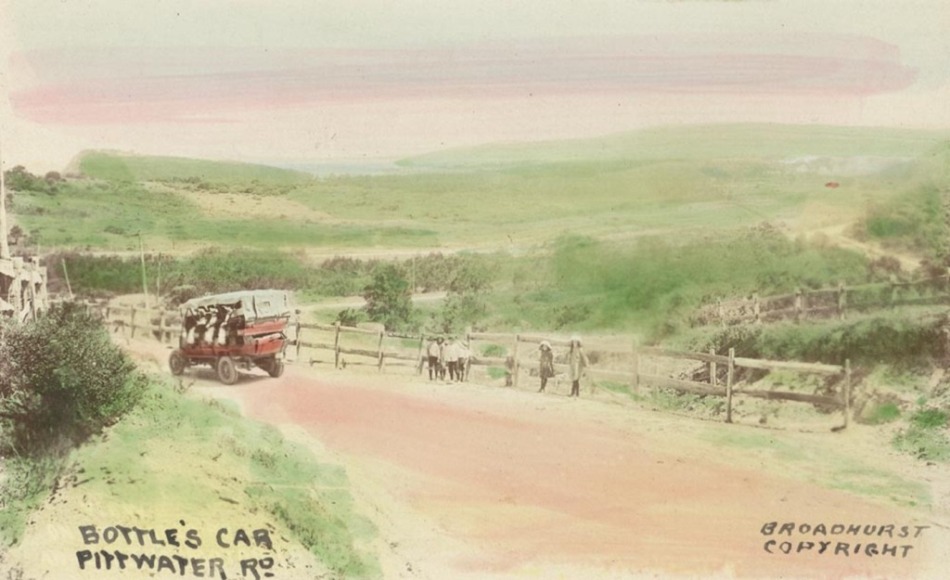
HASTIE.—September 13th 1940, at his residence Careel Bay, Newport, Charles John Lawson Hastie, dearly beloved husband of Isabella Jane Hastie and loving father of Jessie (Mrs. Wilson) Isobel (Mrs. Colwell) and Bessie (Mrs. Baker) Aged 75 years. Family Notices (1940, September 14). The Sydney Morning Herald (NSW : 1842 - 1954), p. 14. Retrieved from http://nla.gov.au/nla.news-article27948065
HASTIE CHARLES JOHN LAWSON 20826/1940 Parents: CHARLES JOHN LAWSON ANNIE MARIA MANLY
The family name of Hastie continues in Pittwater
Bilgola Walter Oswald WATT
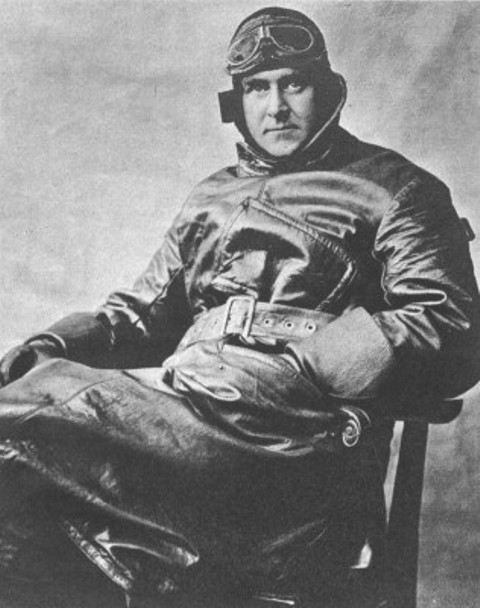 Place of birth Bournemouth England
Place of birth Bournemouth England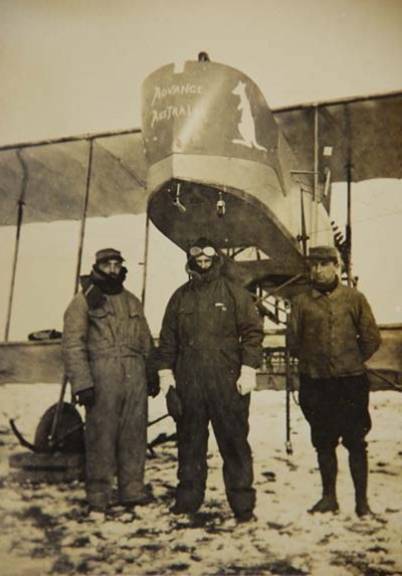
Above: In Winter kit before his plane 'Advance Australia'
Newport The Sons of Robert and Ann Porter
Mr. Robert Porter Snr. came to Newport from Manly – he was a maintenance man on the roads, appearing in a Warringah Shire Council minute of meeting as early as their 12th Meeting in 1906 , 'attesting to the accuracy of his worksheet'. Acounts passed for payment at this Meeting were: '£9 - 2 - 10' - Robert Porter.
Mr. Porter's work stretched from the 9 mile peg to Barranjoey as well as to Bayview and Church Point. He also ensured Newport Public school had adequate firewood during the colder months for years when this was the means for keeping pupils warm.
PORTER-RATTLEY. - At Waverley, in the Wesleyan Church, by the Rev. K. A. Corner, Robert Porter, late of Hoddesdon, Herts, to Ann, third daughter of Mr. David Rattley, of Stroud. Family Notices (1884, August 13). The Sydney Morning Herald (NSW : 1842 - 1954), , p. 1. Retrieved from http://nla.gov.au/nla.news-article13559577
Hoddesdon is a town in the Broxbourne borough of the English county of Hertfordshire, situated in the Lea Valley. It grew up as a coaching stop on the route between Cambridge and London. - Wikipedia
Ann was born in 1859 to David (some sources state ‘Daniel’) Rattley and Ann Horwood, the 3rd eldest daughter of seven girls and two sons. Her parents married shortly before immigrating to Australia, arriving on board the "Rose of Sharon" on April 13, 1855. They couple were devout Methodists; a faith Carl also practiced, and gave to his sons, and promulgated in word, action and attitude, even after or especially because of what he had experienced.
The children of Robert and Ann Porter, and year of birth:
20261/1894 PORTER CARL H ROBERT ANN MANLY
4582/1899 PORTER LUCY M ROBERT ANN MANLY
12236/1885 PORTER FRANCES M ROBERT ANN MANLY
13099/1886 PORTER ROBERT D ROBERT ANN MANLY
20940/1890 PORTER WILLIAM J ROBERT ANNIE MANLY
14196/1901 PORTER SEPTIMUS E ROBERT ANN MANLY
32040/1896 PORTER WALTER S ROBERT ANNIE MANLY
32041/1896 PORTER ALBERT E ROBERT ANNIE MANLY
21623/1892 PORTER SYDNEY G ROBERT ANNIE MANLY
The family’s home, in the Avenue, Newport, is on early cartographic sales maps dated 1900, and was called simply “Home” during a prolonged era when people gave names to their homes. This choice may indicate a family that wanted just that, a home, or that the warmth and love that fills a house and makes it a home thrived there.
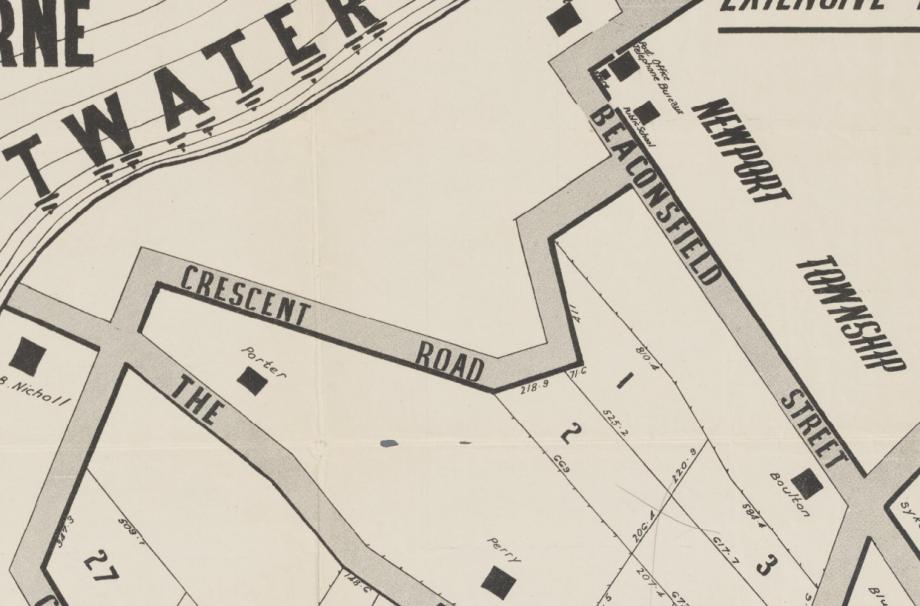
Section from: Sales plan for land in Mona Vale, New South Wales. "A.W. Stephen, licensed surveyor RPA, 47 Castlereagh Street". Sales plan of Mona Vale estate, Pittwater. Mona Vale [cartographic material]. Mona Vale estate, Pittwater [cartographic material] 1900 - 1909. MAP Folder 103, LFSP 1554. Courtesy National Library of Australia.
The article that began inspired an investigation into the Porter brothers service:
FIVE SOLDIER BROTHERS.
PRIVATE BERT PORTER, 19. PRIVATE CARL PORTER, 21. PRIVATE SIDNEY PORTER, 23. PRIVATE ROBERT D. PORTER, 20. SONS OF MR. ROBERT PORTER, OF NEWPORT, MANLY. PRIVATE WILLIAM JAMES PORTER, 25 (wounded).
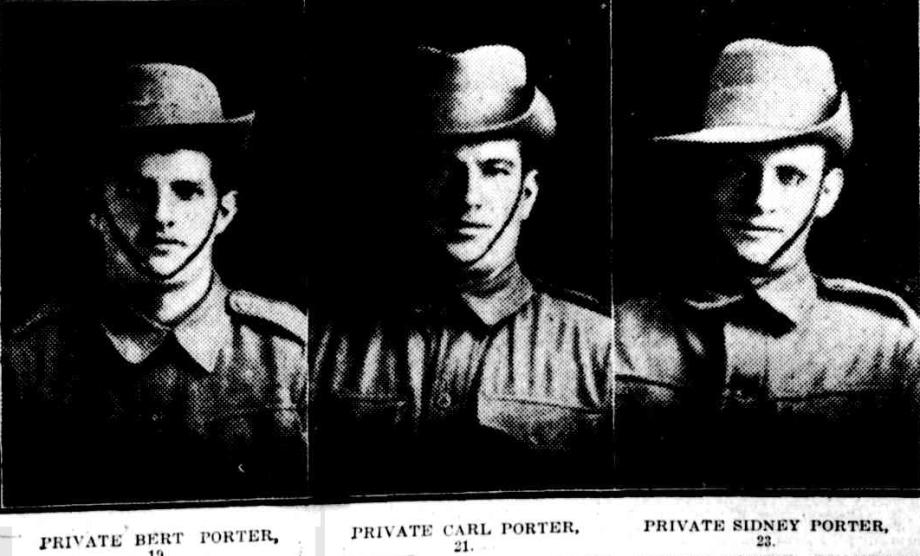
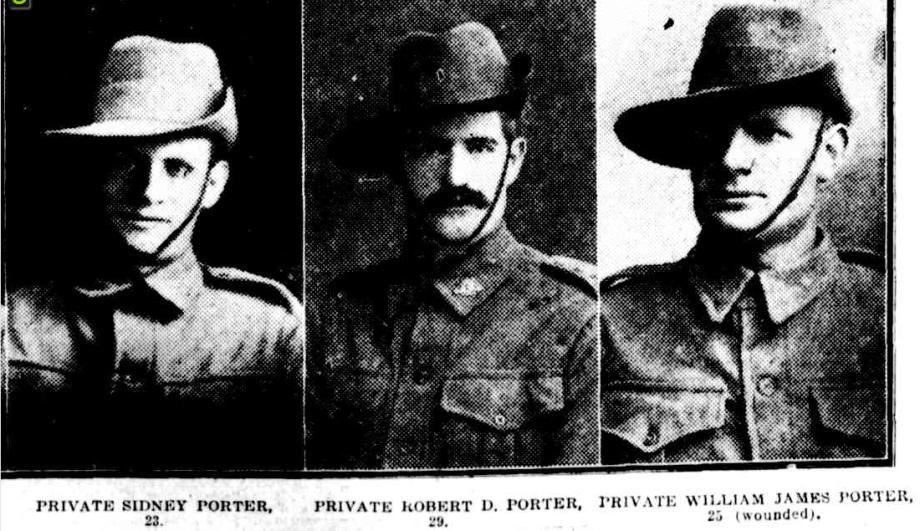
Mr. and Mrs. Robert Porter, of Newport, have reason to be proud of their sons, five of whom have enlisted and are at, or on their way to the front.
The first of the sons to get into khaki was William, aged 23. He went away from Sydney with one of the first contingents, and going through the famous landing at Gabe Tepe on April 25 scatheless, he was in the trenches for nearly four months before he was wounded. His parents were officially advised of his casualty at the time, but since then no news has reached them as to his condition, notwithstanding the fact that a number of inquiries have been made.
Robert, the eldest son, aged 29, was the next one to see his path of duty. The other three sons, Sydney, aged 23, Carl, 21, and Bert, 19, left recently with one of the contingents from Sydney for the front. FIVE SOLDIER BROTHERS. (1916, January 22). The Sydney Morning Herald (NSW : 1842 - 1954), , p. 10. Retrieved from http://nla.gov.au/nla.news-article15638624
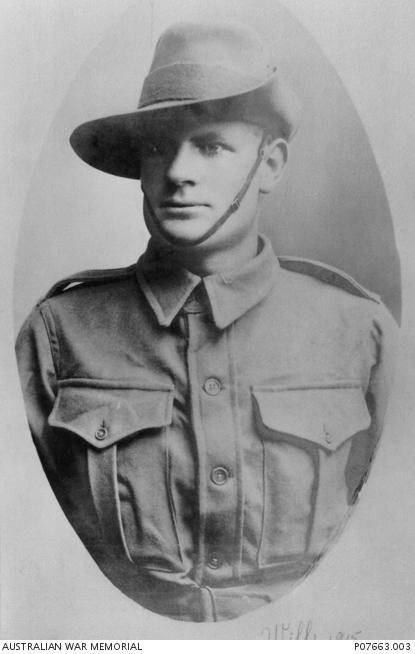 Private (Pte) William James Porter, 13th Battalion, was a policeman prior to enlistment. He embarked with B Company from Melbourne on HMAT Ulysses on 22 December 1914.
Private (Pte) William James Porter, 13th Battalion, was a policeman prior to enlistment. He embarked with B Company from Melbourne on HMAT Ulysses on 22 December 1914.
Right: Studio Portrait William James, courtesy Australian War Memorial
He was killed in action at Hill 60, Gallipoli, Turkey, on 22 August 1915, aged 25.
He has no known grave and is commemorated on the Australian Memorial at Lone Pine.
Robert Daniel Porter enlisted on July 2nd, 1915, at Liverpool - listing his age as 28 years and 8 months and stating he had done a 5 year apprenticeship with G S Brock, listing his trade as ‘Carpenter’. He left Australia on October 5th, 1915, arriving 6/1/1916 at Tebel Kebir.
Appointed Lt. Corporal ‘In The Field” 26.10.1916
5.12.1916 – admitted to Hospital ‘Influenza’ – at New Zealand Staff Hospital (in the Field) – was transferred to Ambulance Train and sent to No 6 General Hospital in Rouen. He finally was released on December 19th and ‘marched to his unit’ and listed as ‘ex-Hospital’ on 5/1/1917 in France.
Promoted to Corporal 6.2.1917
Transferred to England as Instructor on 22.3.1917, attended Number 1 Officers DNCO’s School and qualified 18.6.1917. In command at Musketry school at Tidsworth – ex 1st Eng., Btn. Durrington 2.7.1917
On 8.10.1917 he was ‘absorbed on strength to 1st Btn. A.I.F. sent to France 20.11.1917
22.11.1917 – sent to hospital – sick – his condition listed as ‘Influenza’ once again. 5.2.1918 – sent to hospital again - sick.
On the 17.4.1918 he was wounded in action, his files records '20.4.1918 – requests to be returned to unit'
5.6.1918 – promoted to Sergeant
On the 18.9.1918 he is wounded in action again and sent to B’ham War Hospital Rednal on 28.9.1918 –"(S.W. abdomen and GSW Bullet in right hip) – 2nd incident – invalided to UK"
On the 30.8.1918 he is Awarded Military Medal. 24.1.1919 – sergeant returned to Australia per “Gargha” or ‘Yargha’
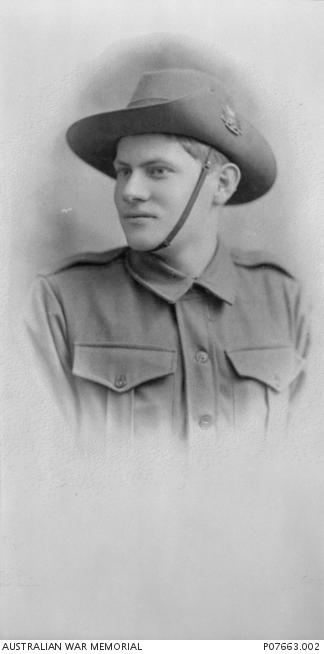 Sydney (spelt in his records ‘Sidney’) George Porter enlisted on October 4th, 1915. He enlisted at Holdsworthy, was assigned to 14th Rein., 3rd Battalion, listing his age as 23 and his occupation as ‘Labourer’. He embarked on the H.M.A.T. R.M.S. “Osterley” on January 15th, 1916. He was transferred from Alexandria on 29/3/1916, per ‘Transylvania’ to France.
Sydney (spelt in his records ‘Sidney’) George Porter enlisted on October 4th, 1915. He enlisted at Holdsworthy, was assigned to 14th Rein., 3rd Battalion, listing his age as 23 and his occupation as ‘Labourer’. He embarked on the H.M.A.T. R.M.S. “Osterley” on January 15th, 1916. He was transferred from Alexandria on 29/3/1916, per ‘Transylvania’ to France.
On June 14th he was wounded ‘slightly’ – then, on June 16th he was wounded in action at Wimereux (GSW – Gun Shot Wound, to the chest, and another to right hand) – 17/6/: admitted to 2nd. Australian Field Ambulance and transferred to England per “St. Denis” where on the 25th of June, 1916 he was admitted to York House Hospital, 1st Auxiliary Hospital. A telegram sent to his father listed this wound as ‘severe’, who wrote in July 1916 inquiring if there was any further news.
On October 1st, 1916 he left England and was assigned to the 53rd Battalion in France.
He too is noted as doing the Musketry Course in January 1917 and he too was sent to hospital sick on April 7th, 1917 only his condition is listed as ‘S.T. ABR Feet’ – more commonly known as ‘Trench Foot’, a condition many soldiers fighting in the First World War suffered from. This was an infection of the feet caused by cold, wet and insanitary conditions and where men had to stand for hours and days in waterlogged trenches. If untreated, trench foot could turn gangrenous and result in amputation. Trench foot was a particular problem in the early stages of the war. As an example, during the winter of 1914-15 over 20,000 men in the British Army were treated for trench foot. Brigadier-General Frank Percy Crozier argued that: " The fight against the condition known as trench-feet had been incessant and an uphill game."
Sydney’s clearly did not get better, as on April 18th he was diagnosed with ‘I.C.T. – left foot’ and transferred to England again, this time on the H.S. ‘Princess Elizabeth’.
He was discharged on June 11th, given some furlough, and told to report to Perham Downs in July. Soon afterwards he was sent back to France and rejoined the 53rd Battalion in the Havre.
On the 28th of September 1917 he was listed as ‘killed in action in the field’: ANZAC Section G.H.Q. British Expeditionary Force.
The 53rd Battalion was raised in Egypt on 14 February 1916 as part of the "doubling" of the AIF. Half of its recruits were Gallipoli veterans from the 1st Battalion, and the other half, fresh reinforcements from Australia. Reflecting the composition of the 1st, the 53rd was predominantly composed of men from the suburbs of Sydney. The battalion became part of the 14th Brigade of the 5th Australian Division.
The battalion arrived in France on 27 June 1916, entered the front line for the first time on 10 July, and became embroiled in its first major battle on the Western Front, at Fromelles, on 19 July. The battle of Fromelles was a disaster. The 53rd was part of the initial assault and suffered grievously, incurring 625 casualties, including its commanding officer, amounting to over three-quarters of its attacking strength. Casualty rates among the rest of the 5th Division were similarly high, but despite these losses it continued to man the front in the Fromelles sector for a further two months.
The 53rd spent the freezing winter of 1916-17 rotating in and out of trenches in the Somme Valley. During this period the battalion earned the nickname "the Whale Oil Guards" after the CO, Lieutenant Colonel Oswald Croshaw, ordered the troops to polish their helmets with whale oil (issued to rub into feet as a trench foot preventative) for a smart turn out on parade. In March 1917, the 53rd participated in the advance that followed the German retreat to the Hindenburg Line. It was spared the assault but did, however, defend gains made during the second battle of Bullecourt. Later in the year, the AIF's focus of operations switched to the Ypres sector in Belgium. The 53rd's major battle here was at Polygon Wood on 26 September.
Third Battle of Ypres
The Third Battle of Ypres was the major British offensive in Flanders in 1917. It was planned to break through the strongly fortified and in-depth German defences enclosing the Ypres salient, a protruding bulge in the British front line, with the intention of sweeping through to the German submarine bases on the Belgian coast. The battle comprised of a series of limited and costly offensives, often undertaken in the most difficult of waterlogged conditions - a consequence of frequent periods of rain and the destruction of the Flanders' lowlands drainage systems by intense artillery bombardment. As the opportunity for breakthrough receded, Haig still saw virtue in maintaining the offensives, hoping in the process to drain German manpower through attrition. The main battles associated with Third Battle of Ypres were:
- Pilckem, 31 July to 2 August
- Langemarck, 16-18 August
- Menin Road, 20-25 September
- Polygon Wood, 26 September to 3 October
- Broodseinde, 4 October
- Poelcapelle, 9 October
- Passchendaele (First Battle), 12 October
- Passchendaele (Second Battle), 26 October to 10 November.
Australian Divisions participated in the battles of Menin Road, Polygon Wood, Broodseinde, Poelcapelle and the First Battle of Passchendaele. In eight weeks of fighting Australian forces incurred 38,000 casualties. The combined total of British and Dominion casualties has been estimated at 310,000 (estimated German losses were slightly lower) and no breakthrough was achieved. The costly offensives, ending with the capture of Passchendaele village, merely widened the Ypres salient by a few kilometres.
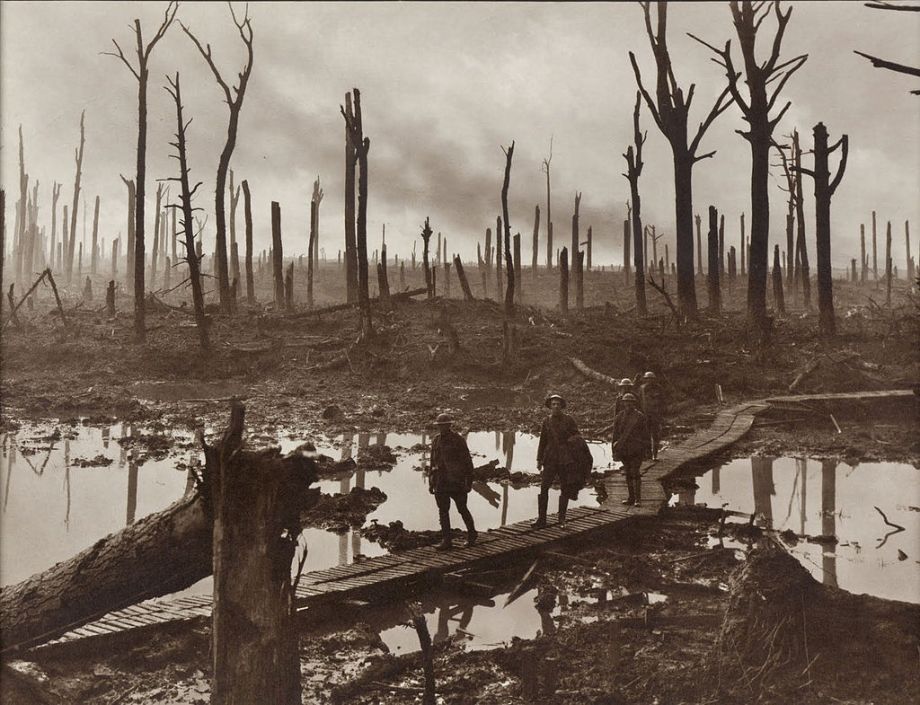
Soldiers of an Australian 4th Division field artillery brigade on a duckboard track passing through Chateau Wood, near Hooge in the Ypres salient, 29 October 1917. The leading soldier is Gunner James Fulton and the second soldier is Lieutenant Anthony Devine. The men belong to a battery of the 10th Field Artillery Brigade. Australian War Memorial E01220. Frank Hurley Photograph.
The Battle of Passchendaele, also known as the Third Battle of Ypres, was a campaign of the First World War, fought by the Allies against the German Empire. The battle took place on the Western Front, from July to November 1917, for control of the ridges south and east of the Belgian city of Ypres in West Flanders, as part of a strategy decided by the Allies at conferences in November 1916 and May 1917. Passchendaele lay on the last ridge east of Ypres, 5 miles (8.0 km) from a railway junction at Roulers, which was vital to the supply system of the German 4th Army. The next stage of the Allied plan was an advance to Thourout–Couckelaere, to close the German-controlled railway running through Roulers and Thourout.
Further operations and a British supporting attack along the Belgian coast from Nieuwpoort, combined with Operation Hush (an amphibious landing), were to have reached Bruges and then the Dutch frontier. The resistance of the German 4th Army, unusually wet weather, the onset of winter and the diversion of British and French resources to Italy, following the Austro-German victory at the Battle of Caporetto(24 October – 19 November), enabled the Germans to avoid a general withdrawal, which had seemed inevitable in early October. The campaign ended in November, when the Canadian Corps captured Passchendaele, apart from local attacks in December and the new year. In 1918, the Battle of the Lys and the Fifth Battle of Ypres were fought before the Allies occupied the Belgian coast and reached the Dutch frontier.
A campaign in Flanders was controversial in 1917 and has remained so. The British Prime Minister Lloyd George opposed the offensive, as did General Ferdinand Foch the French Chief of the General Staff. Field Marshal Douglas Haig, commanding the British Expeditionary Force, did not receive approval for the Flanders operation from the War Cabinet until 25 July. Matters of dispute by the participants, writers and historians since the war, have included the wisdom of pursuing an offensive strategy in the wake of the Nivelle Offensive, rather than waiting for the arrival of the American Expeditionary Forces in France.
The choice of Flanders over areas further south or the Italian front, the climate and weather in Flanders, the choice of General Hubert Gough and the Fifth Army to conduct the offensive, debates over the nature of the opening attack and between advocates of shallow and deeper objectives, have also been controversial. The passage of time between the Battle of Messines (7–14 June) and the opening attack of the Battles of Ypres, the extent to which the internal troubles of the French armies motivated British persistence with the offensive, the effect of the weather, the decision to continue the offensive in October and the human cost of the campaign on the soldiers of the German and British armies, have also been argued over ever since.
Battle of Polygon Wood
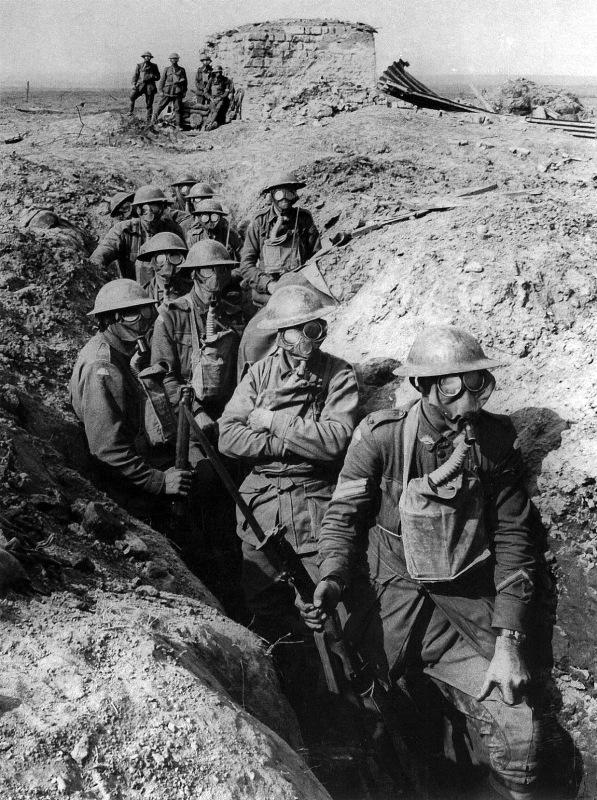
Australian infantry with small box respirator gas masks, Ypres, September 1917. Photo by Captain Frank Hurley. - This image is available from the Collection Database of the Australian War Memorial under the ID Number: E00825
The Second Army altered its Corps frontages soon after the attack of 20 September, for the next effort (26 September – 3 October)so that each attacking division could be concentrated on a 1,000 yards (910 m) front. Roads and light railways were extended to the new front line, to allow artillery and ammunition to be moved forward. The artillery of VIII Corps and IX Corps on the southern flank, simulated preparations for attacks on Zandvoorde and Warneton. At 5.50 a.m. on 26 September, five layers of barrage fired by British artillery and machine-guns began. Dust and smoke thickened the morning mist and the infantry advanced using compass bearings.[108] Each of the three German ground-holding divisions attacked on 26 September, had an Eingreif division in support, twice the ratio of 20 September. No ground captured by the British was lost and German counter-attacks managed only to reach ground to which survivors of the front-line divisions had retired.
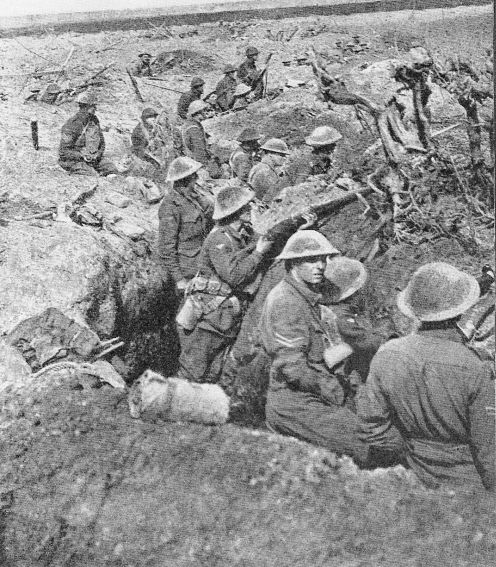
Australian soldiers at the Battle of Polygon Wood. Australian soldiers in trenches at the Battle of Polygon Wood. Courtesy State Library of New South Wales https://en.wikipedia.org/wiki/Battle_of_Polygon_Wood
At the Battle of Fromelles in July 1916, where the battalion took part in the first stages of the Allied attack they suffered over 600 casualties, a total which equated to around a third of their total casualties for the war.
His name is listed: The Ypres (Menin Gate) Memorial (Panel 53), Belgium
The Menin Gate Memorial (so named because the road led to the town of Menin) was constructed on the site of a gateway in the eastern walls of the old Flemish town of Ypres, Belgium, where hundreds of thousands of allied troops passed on their way to the front, the Ypres salient, the site from April 1915 to the end of the war of some of the fiercest fighting of the war.
The Memorial was conceived as a monument to the 350,000 men of the British Empire who fought in the campaign. Inside the arch, on tablets of Portland stone, are inscribed the names of 56,000 men, including 6,178 Australians, who served in the Ypres campaign and who have no known grave.
The opening of the Menin Gate Memorial on 24 July 1927 so moved the Australian artist Will Longstaff that he painted 'The Menin Gate at Midnight', which portrays a ghostly army of the dead marching past the Menin Gate. The painting now hangs in the Australian War Memorial, Canberra, at the entrance of which are two medieval stone lions presented to the Memorial by the City of Ypres in 1936.
Since the 1930s, with the brief interval of the German occupation in the Second World War, the City of Ypres has conducted a ceremony at the Memorial at dusk each evening to commemorate those who died in the Ypres campaign.
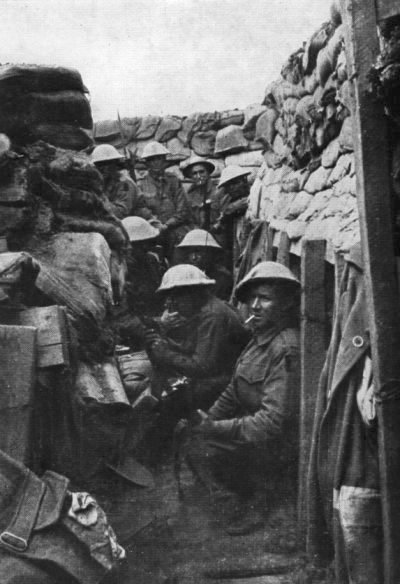
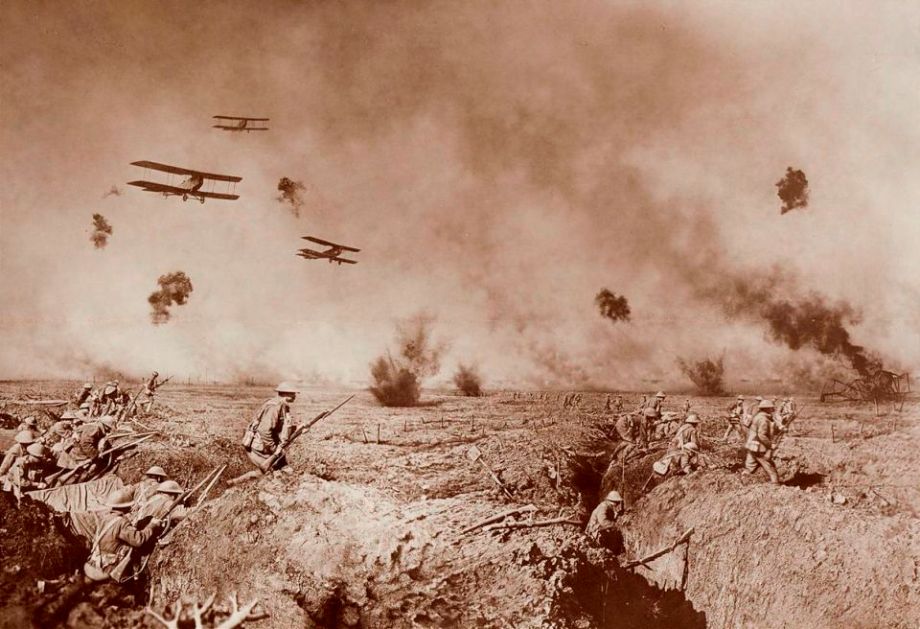
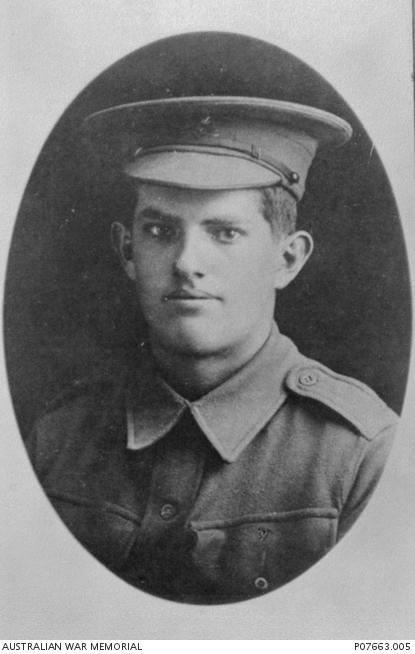 Albert (Bert) Edward Porter was 18 years and 11 months when he enlisted on the 15th of September, 1915, at Holdsworthy, listing his occupation as “Labourer” – his height was 5 feet 6 ½ inches, his weight 138 pounds. Due to his age he was required to get the signature of both his parents on a consent form. Albert was assigned to the 14th Rein., 3rd Battalion.
Albert (Bert) Edward Porter was 18 years and 11 months when he enlisted on the 15th of September, 1915, at Holdsworthy, listing his occupation as “Labourer” – his height was 5 feet 6 ½ inches, his weight 138 pounds. Due to his age he was required to get the signature of both his parents on a consent form. Albert was assigned to the 14th Rein., 3rd Battalion.He has no known grave and is commemorated at the Australian War Memorial at Villers Bretonneux France.
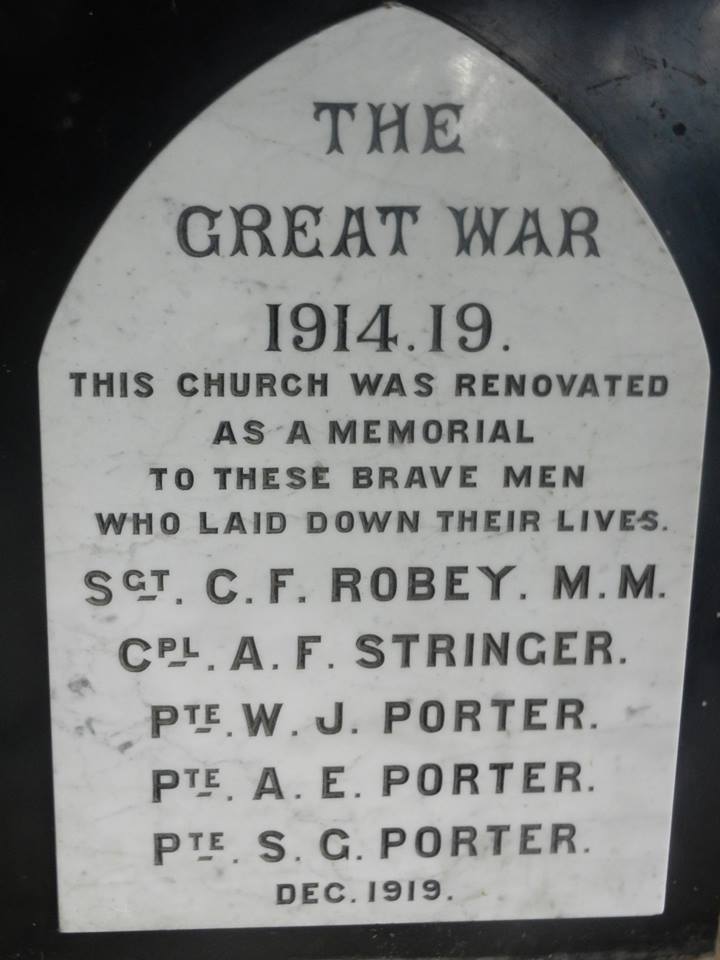
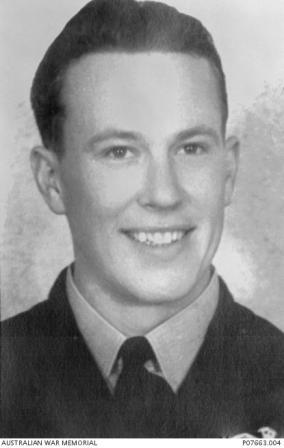 This influenza was called 'Spanish' as wartime censors were minimising the reports of this disease causing illness and death coming out of France, Germany, Britain but had no problem with its effects in Spain being reported.
This influenza was called 'Spanish' as wartime censors were minimising the reports of this disease causing illness and death coming out of France, Germany, Britain but had no problem with its effects in Spain being reported.He passed away in 1979.
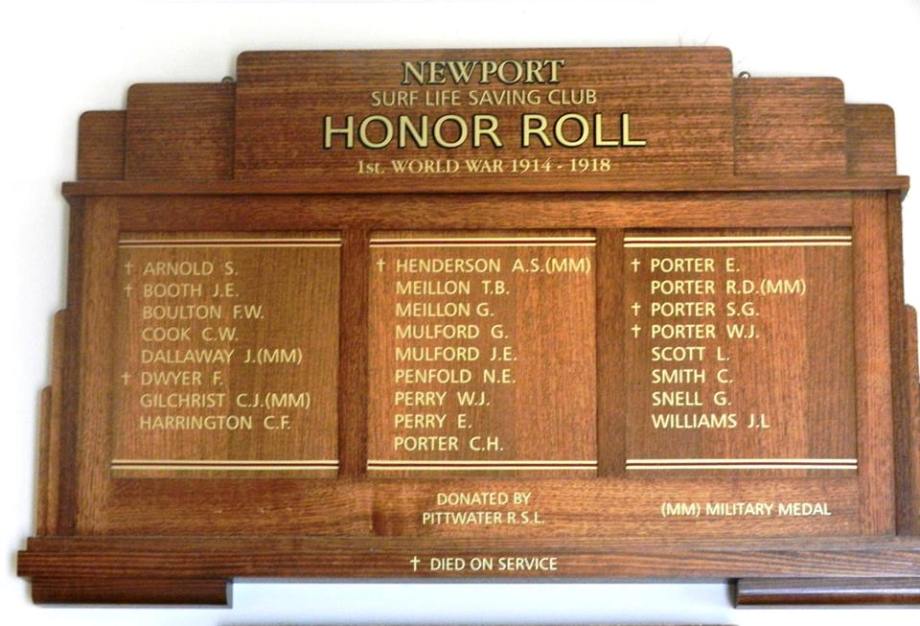
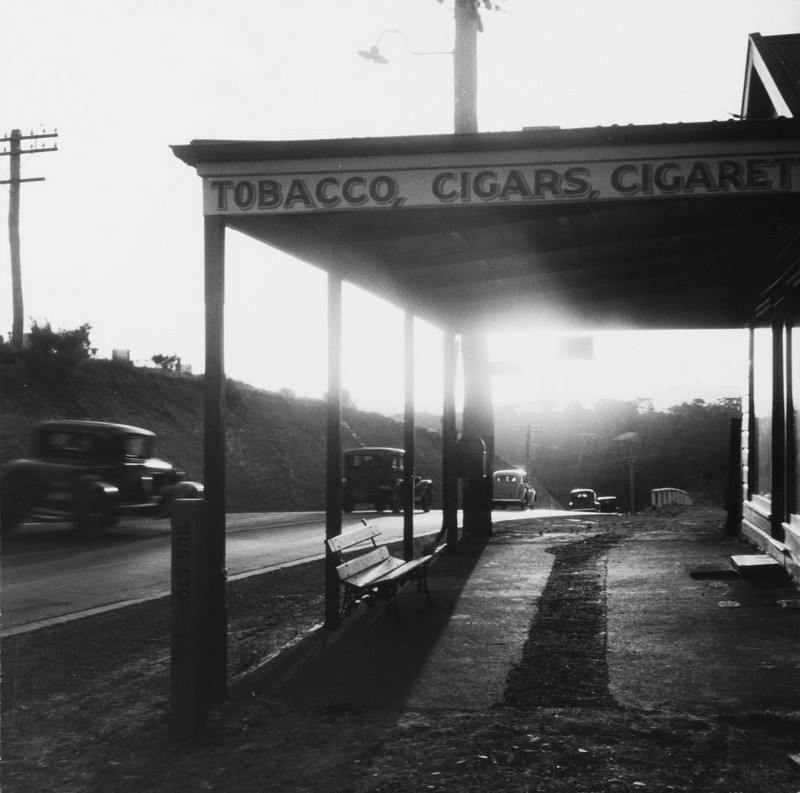
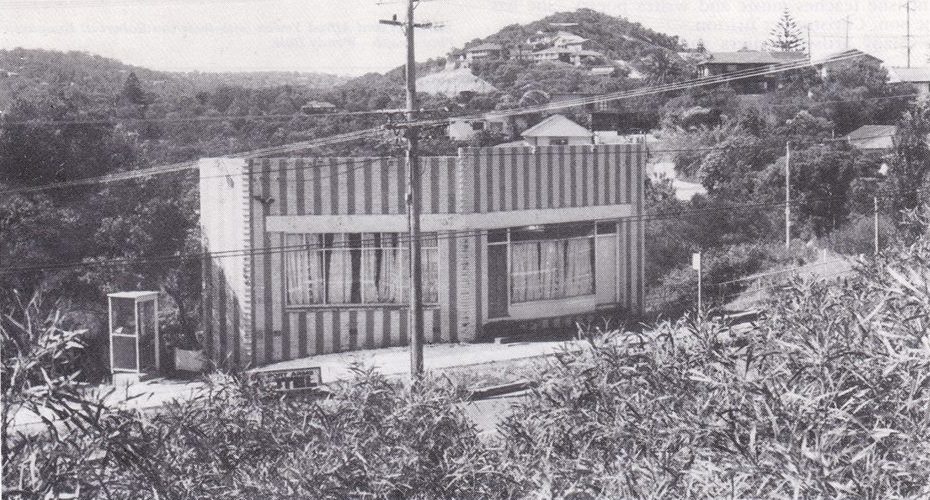
Scotland Island (& Bayview) Herbert Charles Lewis GODBOLD + Albert WATERER
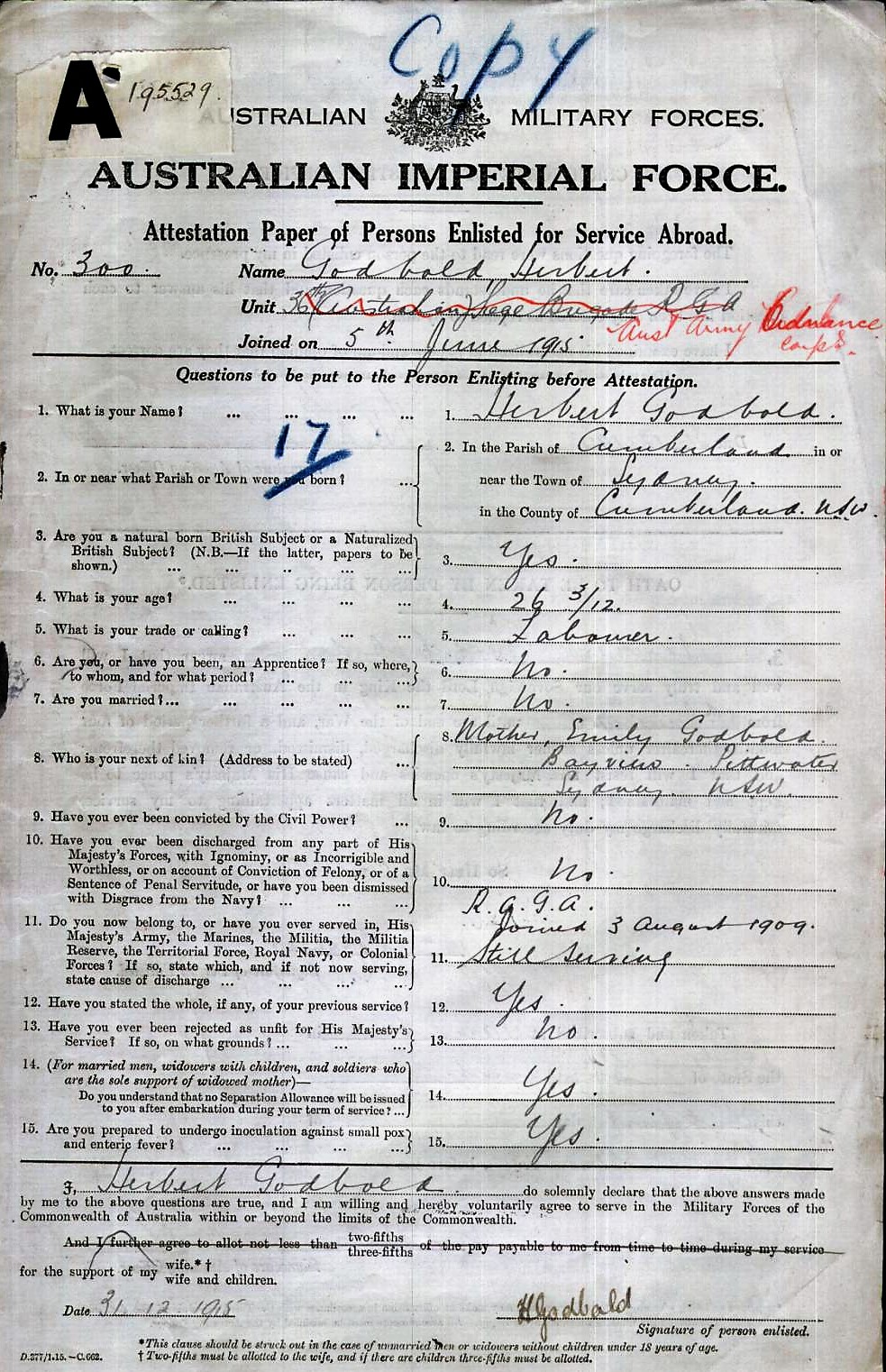
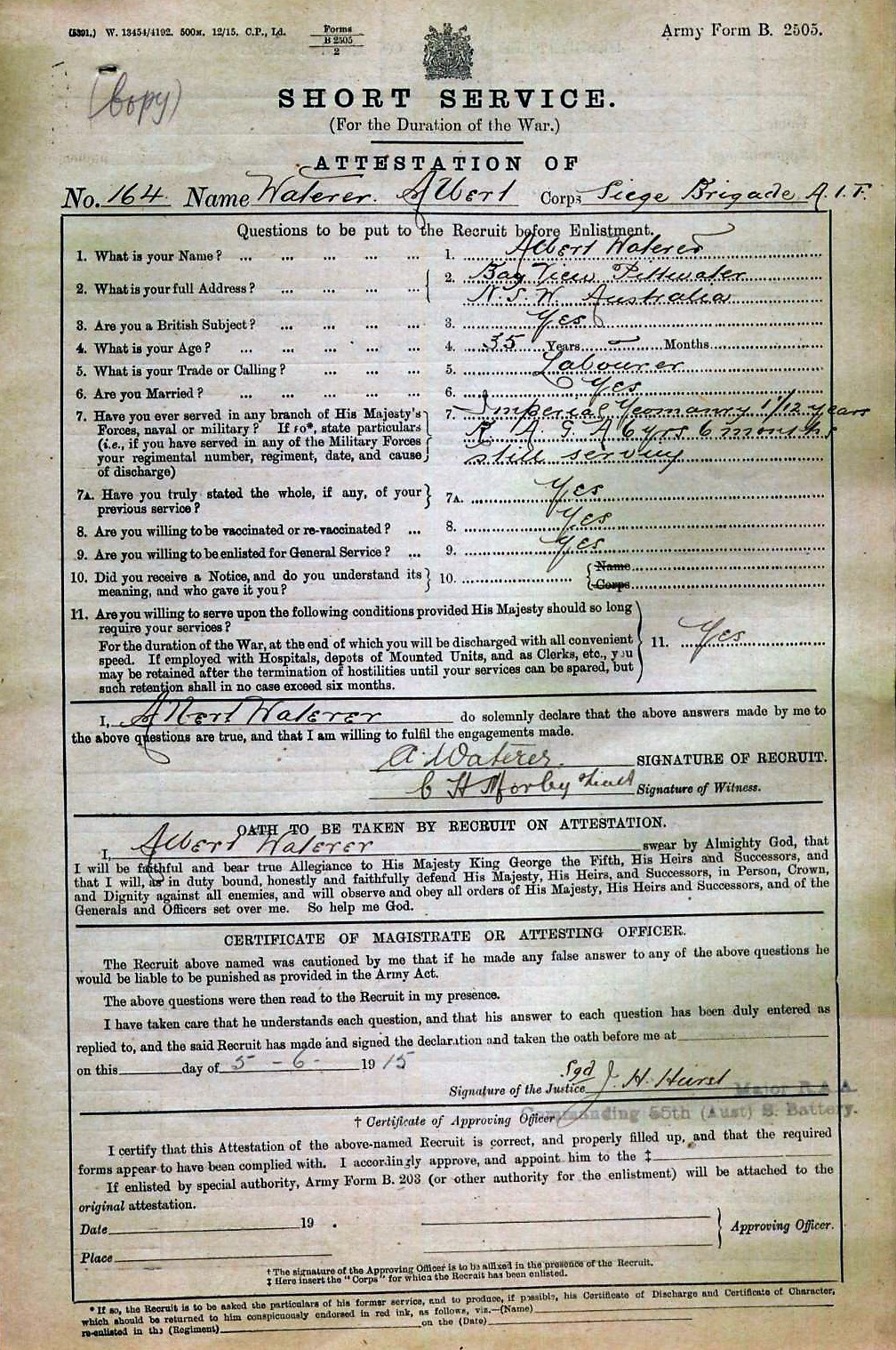
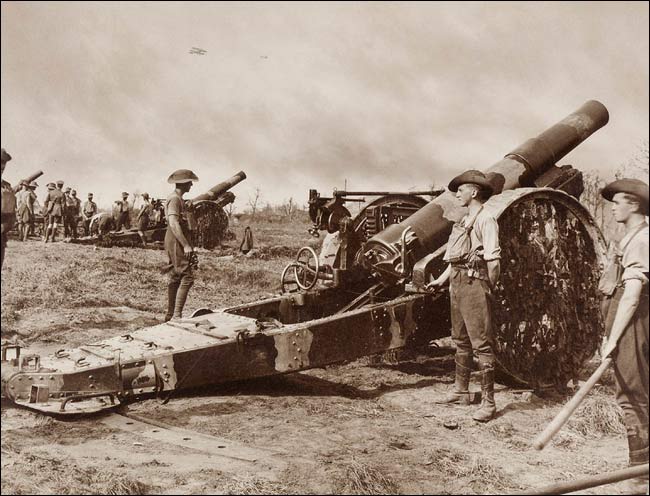
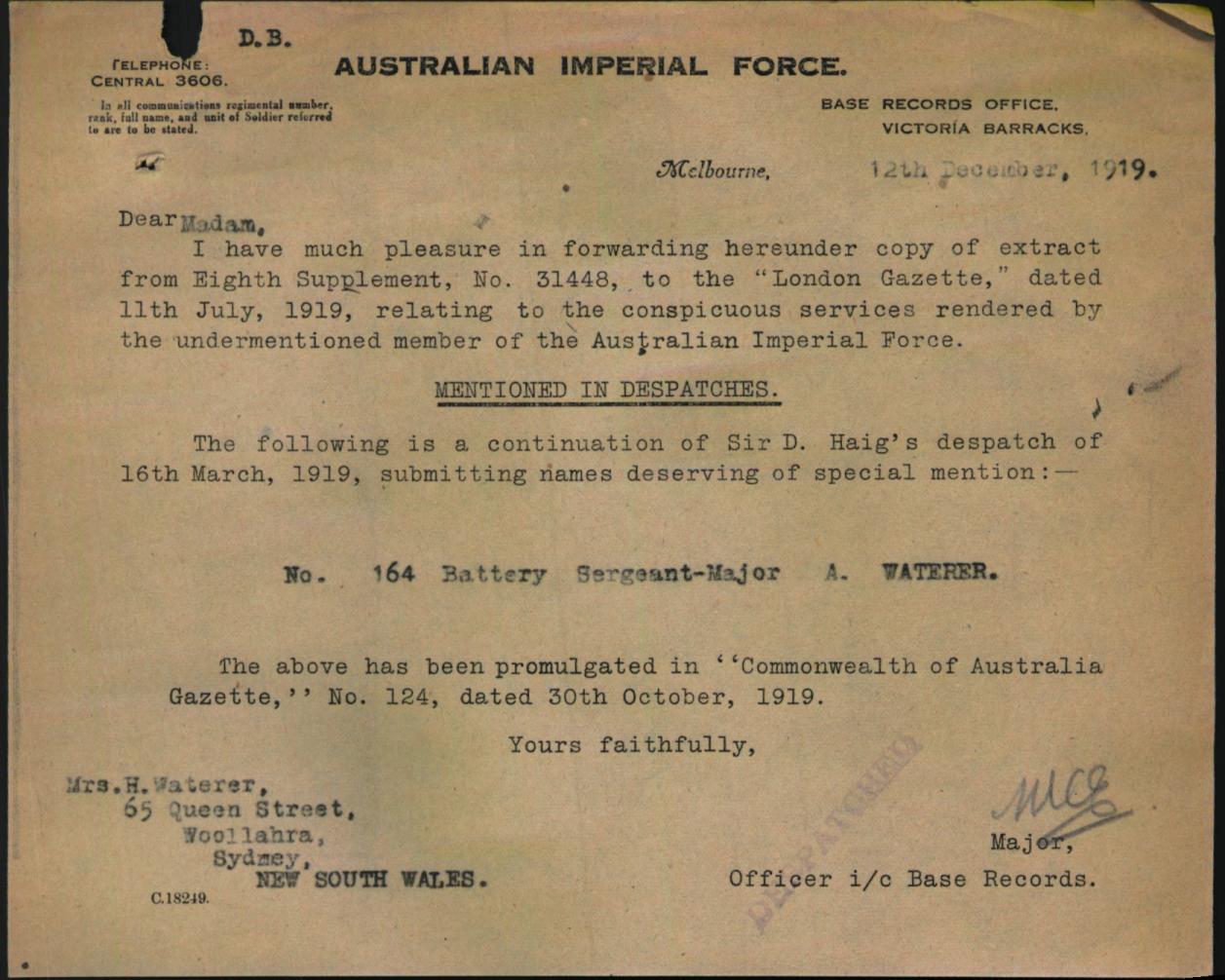
Mona Vale (& Palm Beach) Reginald augustus hOWLETT
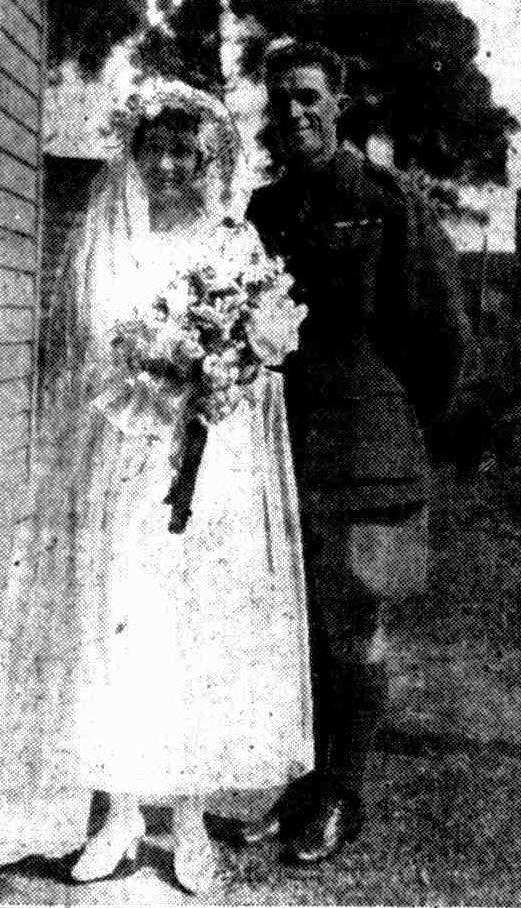
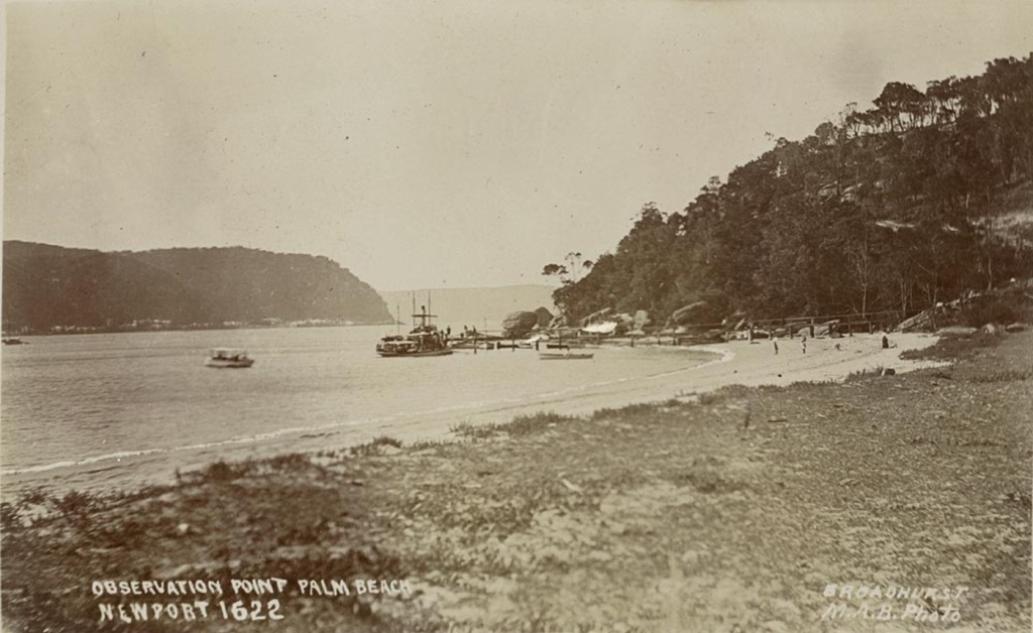
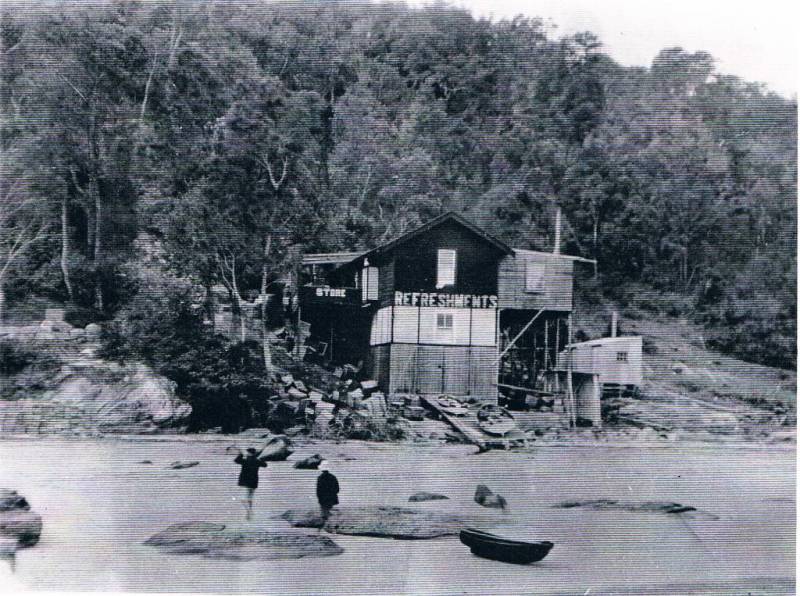
Above and Below: Gow's Store in its early days courtesy Peter Verrills
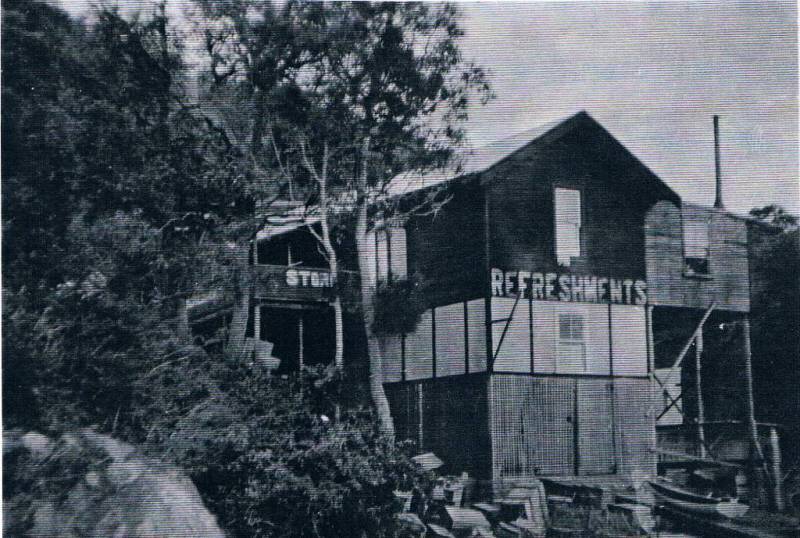
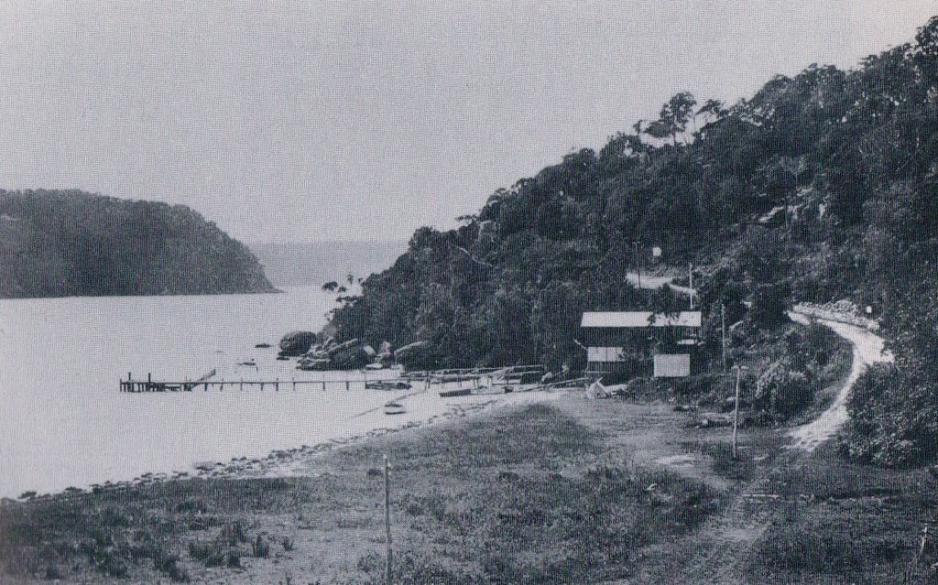
Gow's jetty was link with the outside world for visitors to Palm Beach - this image circa 1920-21. Courtesy Peter Verrills.
Carl Gow and Reginald took over this property from a man named Ellis who in turn had taken it over from James Booth, a well-known early builder employed by the Barrenjoey Company. Above this jetty (known as Gow's Wharf) the first General Store, originally called 'Booth's Store' after James Booth, the stonemason/builder credited with constructing that first wharf became a Howlett-Gow concern. A few other threads indicate late 1919 as being when the pair had taken over the jetty and store. Carl seems to have had a talent for being on the water and around boats, becoming a successful fisherman, so it may have been Reginald and his bride who kept the store to begin with:
DISTRICT COURT. (Before Judge Backhouse.) CONTRACTOR'S CLAIM. Alfred Wrigley Ellis, of Palm Beach, near Barrenjoey, sued Bernard Stiles, of Yarrandi, Church-street, Newtown, medical practitioner, and P. M. Stiles, his wife, for money alleged to be due under a contract. The claim, £68 19s 1d, was for time and money lost owing to the stopping by the defendants of their contract with the plaintiff for the erection of a cottage at Palm Beach. The defendants paid £18 15s into court, and denied further liability. Mr. A. R. J. Watt, instructed by Messrs. John M’Laughlin and Son, appeared for the plaintiff, and Mr. Clive Teece, instructed by Mr. J. T. Ralston, for the defendants. His Honor returned a verdict for the plaintiff for the amount paid into court. DISTRICT COURT. (1918, March 13). The Sydney Morning Herald (NSW : 1842 - 1954), p. 9. Retrieved from http://nla.gov.au/nla.news-article15773331
PALM BEACH.-Furnished Cottages to Let and For Sale.- Gow and Howlett, Store. Phone. 24. Advertising. (1921, April 23). The Sydney Morning Herald (NSW : 1842 - 1954), p. 4. Retrieved from http://nla.gov.au/nla.news-article28086899
This, despite the wonderful spelling of their names, indicates the pair were part of the Palm Beach landscape, and had been for a while:
The first general store was at Palm Beach, on the Pittwater side near the jetty, as early as 1914, and was known as Booth's store. Later it became Ellis' store, and then after the last war two returned Diggers, Mr. Fred Howlett and his partner, Gowe, took it over. Their general supplies came by ship from Sydney by the Erringhi and the Kallawatta, and meat and bread came by launch from Newport. They made their own ice-cream in those days, and froze it in old fashioned freezers with coarse salt. It was just as popular as the well known brands are today.
It was not until 1929 that Howlett's store was established on the beachside of Palm Beach. Before that there was no road through from Pittwater, and the top road was used by residents. Palm Beach setting for smartest sea and sun togs. (1946, January 12). The Australian Women's Weekly (1933 - 1982), p. 22. Retrieved from http://nla.gov.au/nla.news-article47245736
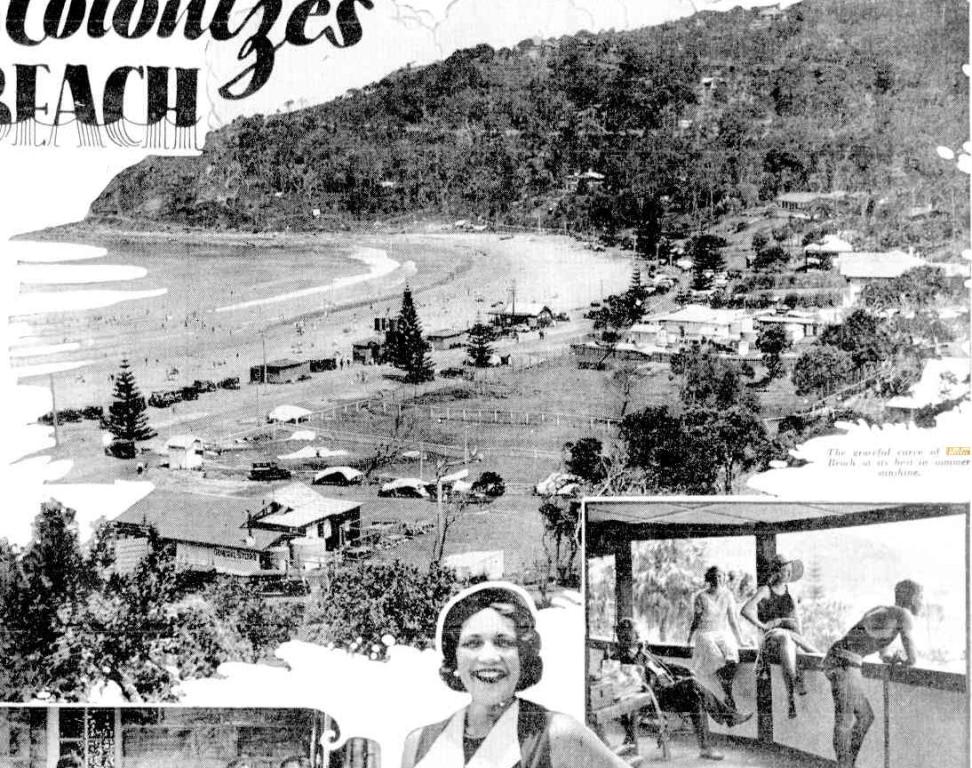
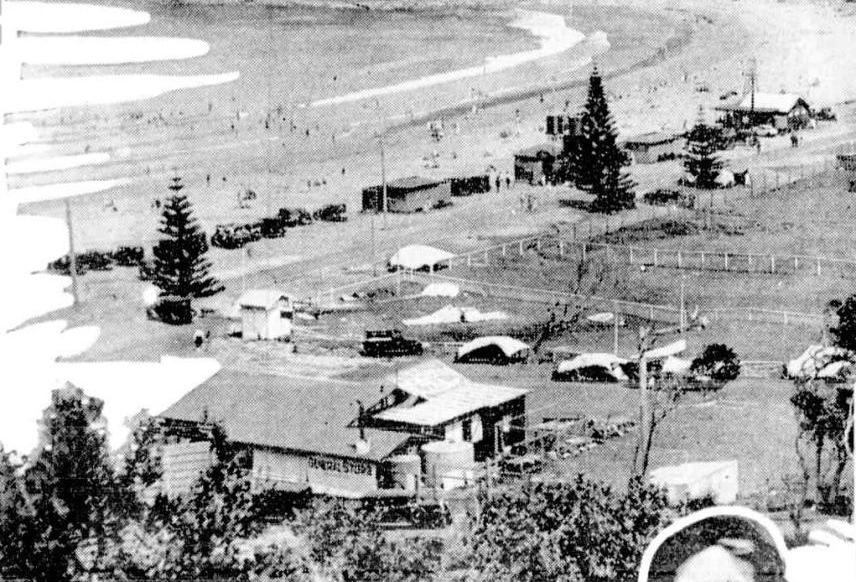
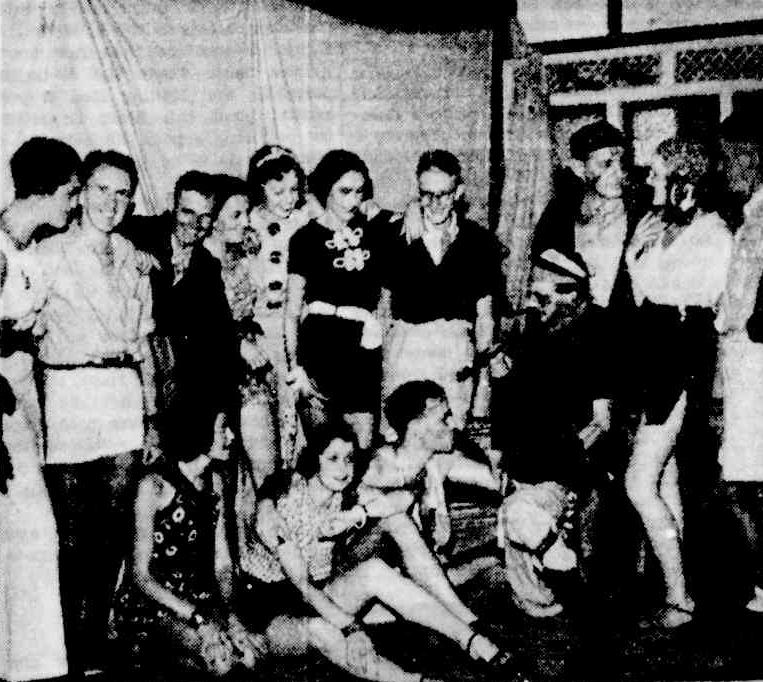 ONE of the cheeriest dances of the season was the Pirates' Dance, staged by members of the Palm Beach Surf Club, at Howlett's Store, Palm Beach, last Saturday.
ONE of the cheeriest dances of the season was the Pirates' Dance, staged by members of the Palm Beach Surf Club, at Howlett's Store, Palm Beach, last Saturday.